









By Tony Kiene Staff Writer
he Minnesota Spokesman-Record-
er launched its 90th Anniversary Celebration weekend in style this past Friday night on its annual Legacy Yacht Cruise. Setting sail down the St. Croix, the historic Majestic Star was at full capacity, and a few early spells of rain ultimately gave way to bright sunshine and a beauti-
ful night sky high above one of America’s original National Scenic Riverways. No matter the weather, nothing would dampen this party, the first of two fabulous nights paying homage to the vision of founder Cecil E. Newman and the force of nature known as the MSR. Phyllis “Showtime” Braxton, the evening’s emcee, kicked off the evening, introducing current MSR CEO and Publisher Tracey Williams-Dillard,
who shared a few short stories about Newman and why, in 1934, he established what today remains the oldest African American-owned business in the North Star State.
“My grandfather moved here from Kansas City, thinking it would be different. But it wasn’t, and he knew the African American community in Minnesota needed a voice.”
Years later, when Hubert H. Humphrey was to become vice president of the United
A trip to the grocery store with an environmentalist
By Binta Kanteh Contributing Writer
ost of us are mindful of waste and overconsumption to some extent. No matter the varied fluctuations of the economy, our habits around making everyday items as multipurpose as possible stay the course.
The dozens of plastic bags in the kitchen cabinet that double as lunch bags and small trash can liners, the vanilla yogurt tubs that are used for other food storage, or the drawer filled with sauce packets and plastic cutlery are some lighthearted indications that, indeed throwing things away that could have another use makes you uncomfortable.
I haven’t been inside your place. I just know.

States, he asked Newman, who’d been his confidant and, in Humphrey’s words, the one that “brought him up to speed on civil rights,” to join him in the White House.
“My grandfather politely declined,” explained WilliamsDillard, noting that Newman said to Humphrey, “‘There is still too much for me to do in Minnesota.’”
Minneapolis City Council
President Andrea Jenkins also contributed brief remarks in
tribute, as did Dr. Benjamin Chavis, president and CEO of the National Newspaper Publishers Association (NNPA).
Chavis, who, as a teenager, began his legendary and wideranging career as a youth coordinator and Dr. Martin Luther King, Jr.’s youngest staffer at the Southern Christian Leadership Conference, told the assembled passengers, “The MSR has long been the eyes, ears, heart, and soul not only of this community in Minne-
sota but nationally as well,” before referring to the MSR’s recent NNPA Messenger Award.
Those fortunate enough to be on the boat were treated to an all-you-can-eat buffet, the chance to shop with Blackowned vendors and take their commemorative MSR 90th Anniversary portrait, purchase brand new MSR merchandise, participate in games and a raffle competition, and even engage Legacy Yacht Cruise sponsors Blue Cross Blue Shield of Minnesota, Hue-Man Partnership, U.S. Bank, and Andersen Windows and Doors.
Bukata Hayes, vice president and chief equity officer with Blue Cross Blue Shield, the weekend’s premier sponsor, stated, “We are so proud to support an institution in Minnesota celebrating a 90year legacy. The MSR has always been at the forefront, ensuring our voices are heard and valued.”
Executive Director of HueMan Partnership Clarence Jones, speaking to why it is important to support the MSR, talked about building authentic relationships and the need to have “all hands on deck.”
“The MSR is essential. It is an invaluable resource, providing accurate, culturally appropriate information about health and other vital issues in our communities.”
As always, the Legacy Yacht Cruise featured first-class entertainment, including composer and pianist Wenso Ashby, talented and emerging singer ■ See MSR on page 4
By Izzy Canizares
innesota Lt. Gov. Peggy Flanagan has been named as one of the co-chairs of this year’s 2024 Democratic National Convention.
The Democratic National Convention Committee (DNCC) named Flanagan, White House Infrastructure Coordinator Mitch Landrieu, New Jersey Senator Cory Booker, and Texas Representative Veronica Escobar (TX) as the four co-chairs for this year’s DNC, which started Monday and runs until Thursday, Aug 22.
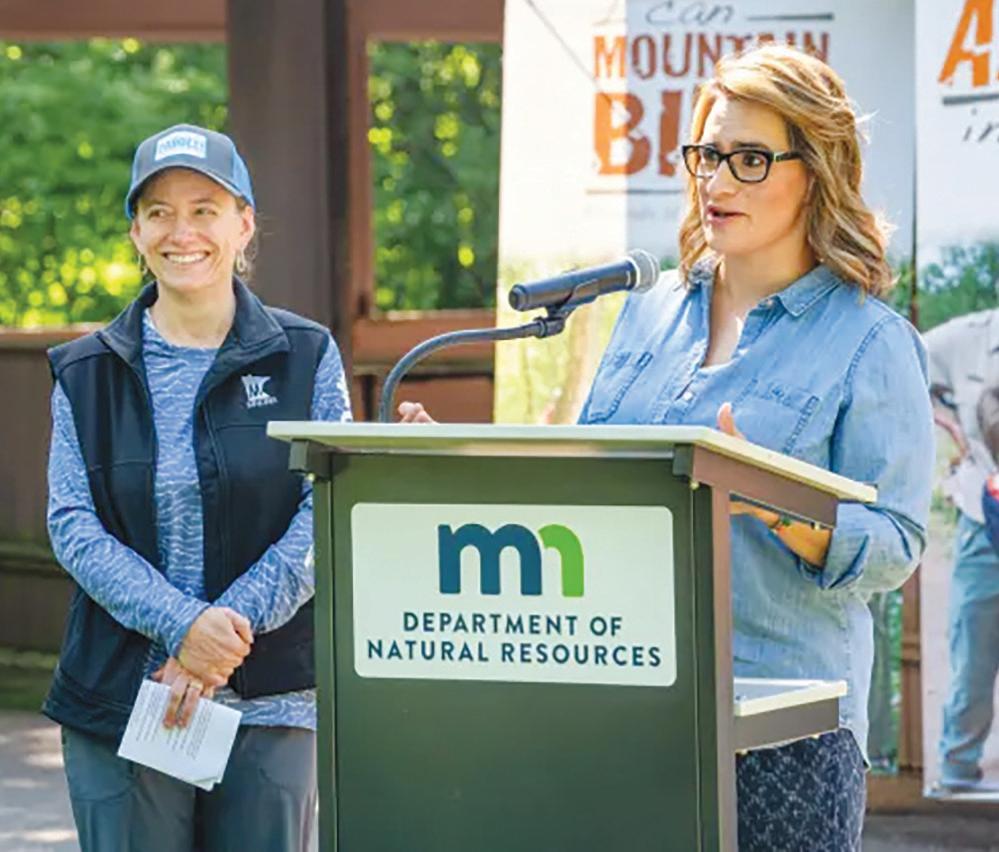
headline speaker last Wednesday, having been selected as the vice-presidential pick of Democratic candidate Kamala Harris, who will close the convention on Thursday.
One person who takes this seriously is Filsan Ibrahim, an environmentalist in her nineto-five job and a mindful consumer daily at all other hours. Over the past decade, Filsan has committed to studying and implementing sustainable
Where we are headed with the amount of stuff we consume—food, new clothes, and single-use products—coupled with current methods of industrial waste management is very concerning at best and somber when you understand the first-hand experiences of populations, often because of location, class, and/or race, that are forced to endure some of the worst impacts on their quality of life.
practices in how she purchases items of all kinds and, subsequently, how she disposes of trash. This approach to mindful consumption can be referred to as a low or zerowaste approach. Filsan’s list of to-dos at Cub Foods during a modest grocery run wasn’t long, but she shared a healthy dose of
“It’s an honor to be named a convention co-chair and to highlight the excitement around secondsin-command right now.”
The quartet will oversee proceedings at the convention. Gov. Tim Walz appeared as the
Flanagan told The Minnesota Star Tribune, “It’s an honor to be named a convention co-chair and “to highlight the excitement around secondsin-command right now.”
Flanagan was elected as Governor Tim Walz’s running mate for his successful gubernatorial run in 2018, ultimately becoming lieutenant governor of Minnesota. Before this, she
served in the House of Representatives for the state’s 46A district. She is the first woman of color to serve as lieutenant governor in Minnesota and the highest-ranking Indigenous woman elected into office. If Harris wins the November election against Donald Trump, Flanagan will take over as governor from Walz and would become the first Native American governor in Minnesota history.
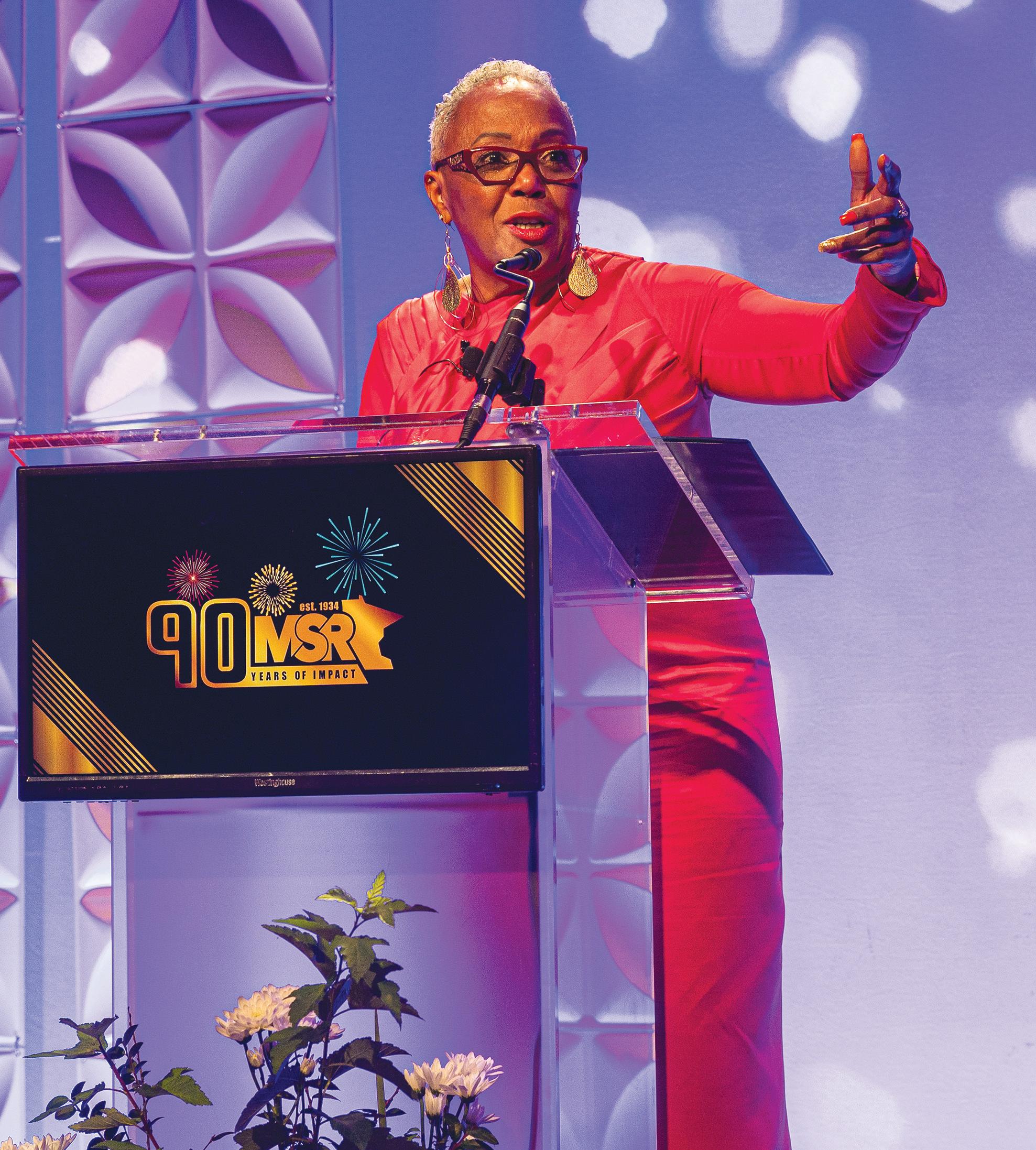
“The entire celebration weekend was superb! Class from start to finish.”
– Harpist Mariea Antoinette
“It was a once-in-a-lifetime experience, and the cruise was awesome. It was a great fellowship, and my family and friends had a great time. The Gala, wow, was breathtaking in every respect.
History in the making. 19342024 – Priceless! Recognized and respected by me since 1960.”
– Elsie Moss Clemons
“Excuse my French. I am so Frick’n proud of YOU. Great Job, Cuzn. Great Job!”
– Dauhn Jackman
“To realize and fulfill your dreams, you must be adaptable and innovative. I had the opportunity to realize mine. From being of service to being present with the community to celebrate the MSR’s 90th anniversary.”
– Dr. Ronda Chakolis
“This is Uncle Jack and Aunt Ruth. This is the morning after. We, your Uncle Jack & Aunt Ruth, realize that you and your committee pulled off a hell of a deal. Mr. & Mrs. Cecil Newman, my sister Norma Jean Williams, and Robert Dillard are extremely proud of you. The event you pulled off last night was one of the finest events we’ve attended in over 70 years.”
– Love With All Our Hearts, Uncle Jack & Aunt Ruth
As we celebrate a momentous milestone—the 90th anniversary of the Minnesota Spokesman-Recorder—I reflect on the remarkable journey that has led us to this point. Founded in 1934 by my grandfather, Cecil E. Newman, our newspaper has witnessed nearly a century of change, challenge, and triumph in the Black community. With profound gratitude, I extend my heartfelt thanks to each of you who has been a part of this historic journey.
To our cherished community, you are not just our readers but the essence of our existence. Your unwavering support over the decades has fueled our mission and passion for the truth and has been the driving force behind our publication. Your voices, stories, and experiences have been the cornerstone of our publication. Your engagement and commitment have allowed us to thrive in a landscape where journalism plays an increasingly vital role. Thank you for believing in and standing alongside us as we strive to represent, inform, and uplift.
I would also like to express my deepest appreciation to our incredible sponsors. Your generous contributions and support have not just made this celebration possible but have also made a significant impact on our community. Your support has enabled us to provide vital information, tell important stories, and uplift our community. A special thank you goes to Blue Cross Blue Shield, Hennepin Healthcare, First Independence Bank, US Bank, North Memorial Health, Anderson Windows and Doors, Twin Cities Habitat for Humanity, kp Companies, HUE-MAN, Minneapolis Foundation, Cultural Wellness Center, U Care, Build Wealth MN, and Twin Cities Care. You
“Best weekend I can remember in a long time.”
– Jimmy Jam (Songwriter/ Music Producer)
”Wonderful event on Saturday! We had a great time”
– Jessi Kingston (North Memorial)
“It was such a pleasure to be at your 90th gala. So many people in the room whom I knew, and so many more who were new to me to connect with.”
– Sheree Curry
have significantly impacted our ability to serve our community and perpetuate our mission.
To my family and our dedicated staff, you are the heartbeat of the Spokesman-Recorder. Your resilience, creativity, and commitment to our values have allowed us to navigate this journey gracefully. It is an honor to continue my grandfather’s legacy and work alongside talented individuals passionate about our community and its future.
Also, thanks to Minneapolis Mayor Jacob Frey and St. Paul Mayor Melvin Carter. Your presence, in person and video, assures our community that you are listening to them through us.
We also look forward to the next 90 years as we celebrate this significant anniversary. Our commitment to serving our community remains unwavering, and we are enthusiastic about what lies ahead. Together, we can continue to build a platform for voices that deserve to be heard, a space for stories that deserve to be told, and a future that reflects our shared values. You can trust that we will continue to be a reliable source of information and a champion for our community.
Thank you once again for being an essential part of our journey. Here’s to our incredible community, generous sponsors, supportive families, friends, and dedicated staff at the Minnesota Spokesman-Recorder. We will continue to forge ahead, creating meaningful change while working towards a brighter future for all.
With gratitude, Tracey Williams-Dillard CEO/Publisher Minnesota Spokesman-Recorder
“I love your publication and will continue to keep up on it on Instagram as I now follow MSR. It’s an incredible legacy; getting to know you and the organization has been a privilege. Cheers to the next 90 years!”
– Nick Loosbrook, Sales Manager Renaissance Minneapolis Hotel, The Depot
“I hope you’re resting and reveling in the glory of a great event!”
– J. Marie Fieger & Nemer Fieger
“With Great Appreciation.”
– Gary Hines
“Congratulations! The ‘Gala’ was SUPER-FANTASTIC, well planned, and excellently executed! I enjoyed Alllll the videos--yes, community!! Get some rest; you deserve it. Your beautiful, intelligent daughter is ready when you are!!!!! I know you’re proud. Your family will always be in my heart.”
– Marcia Murray









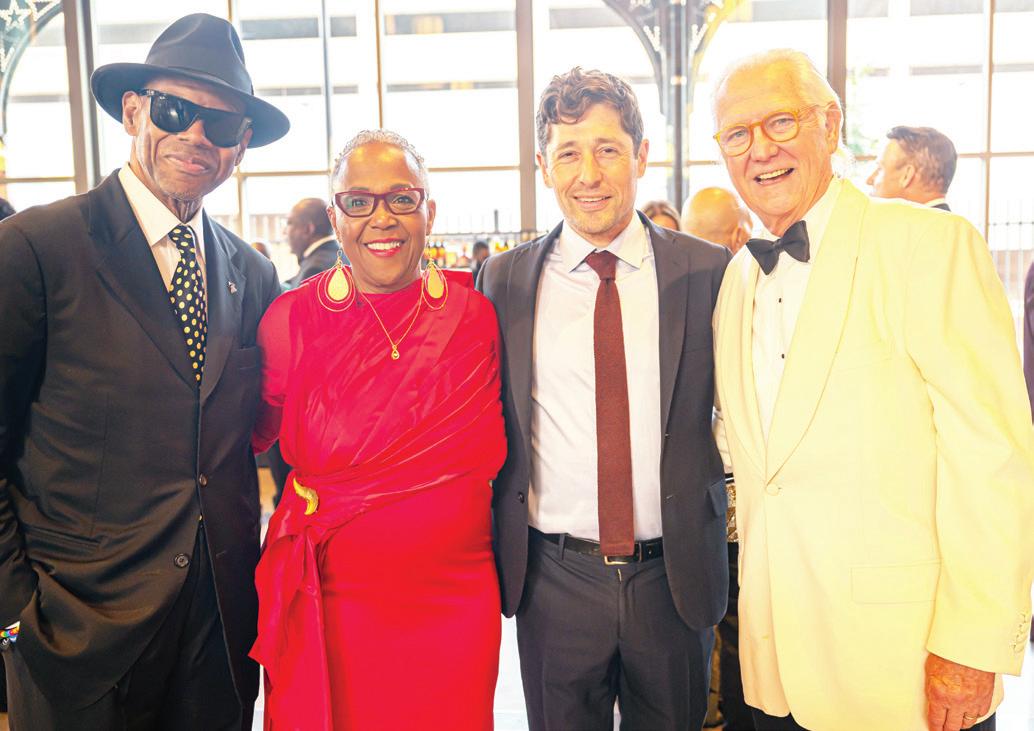
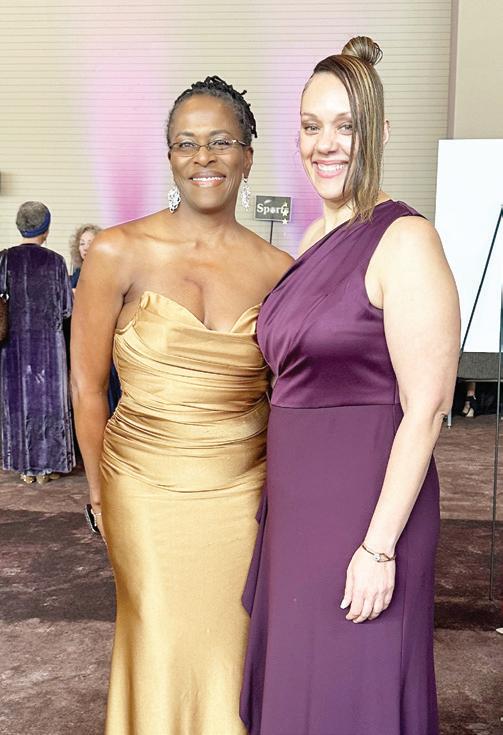
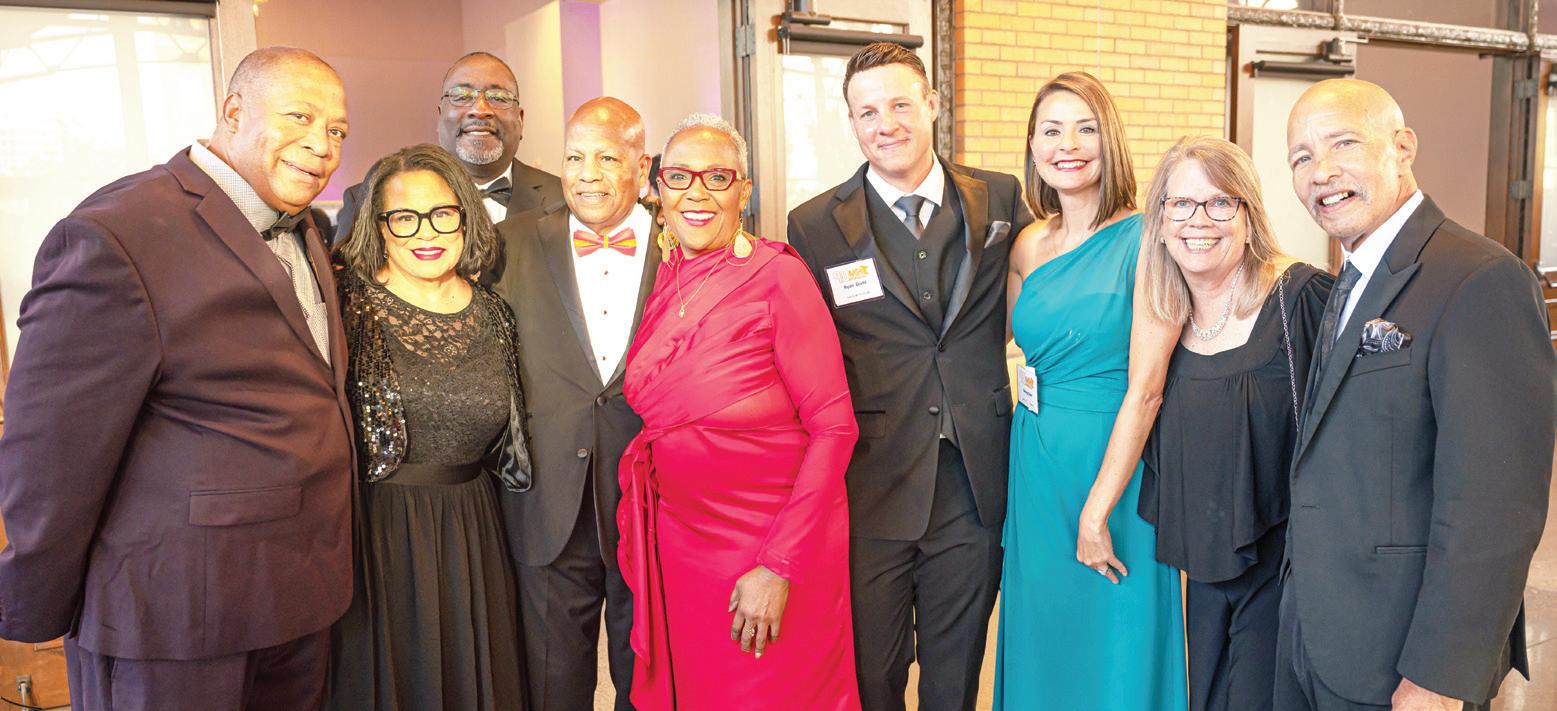
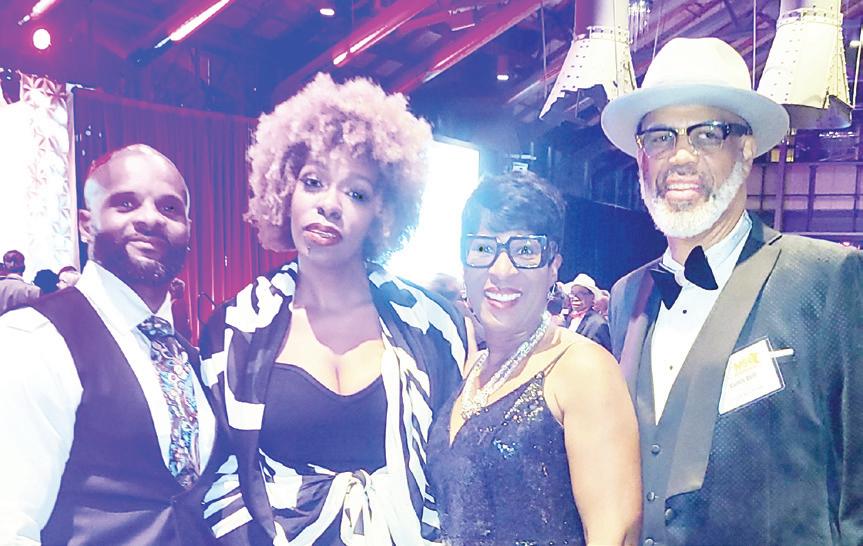
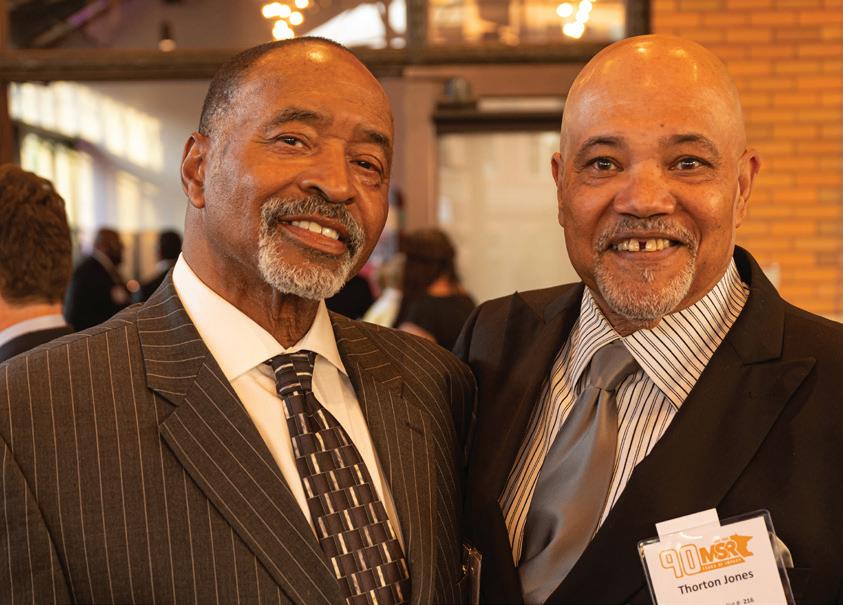
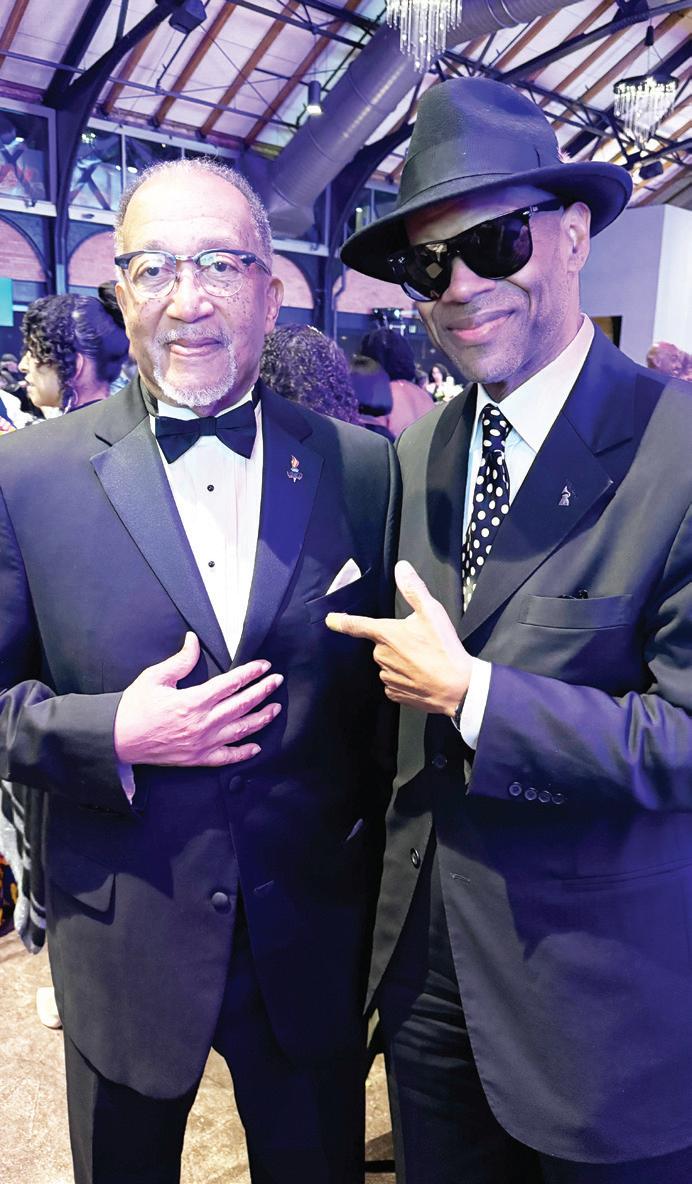
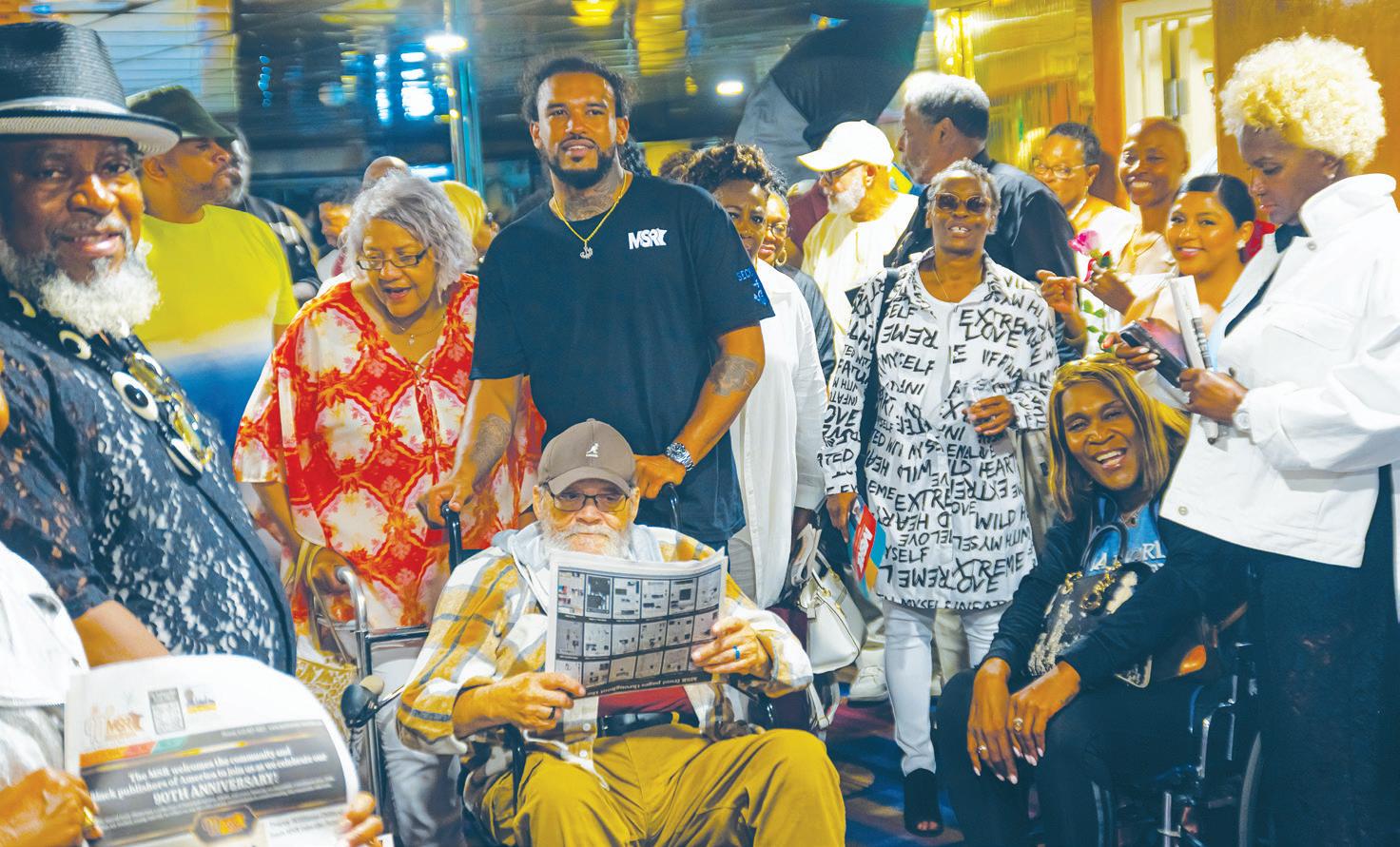
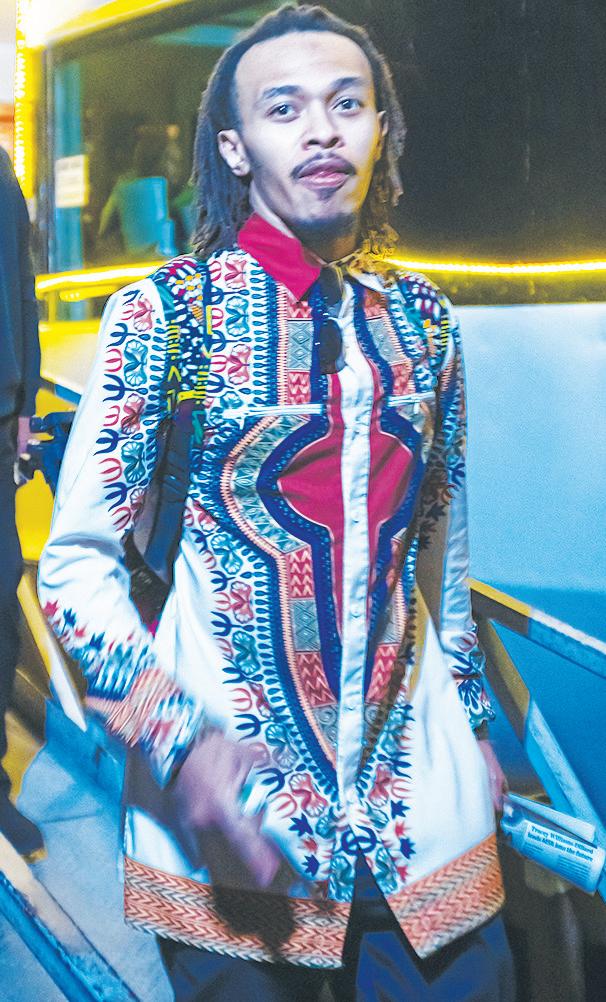

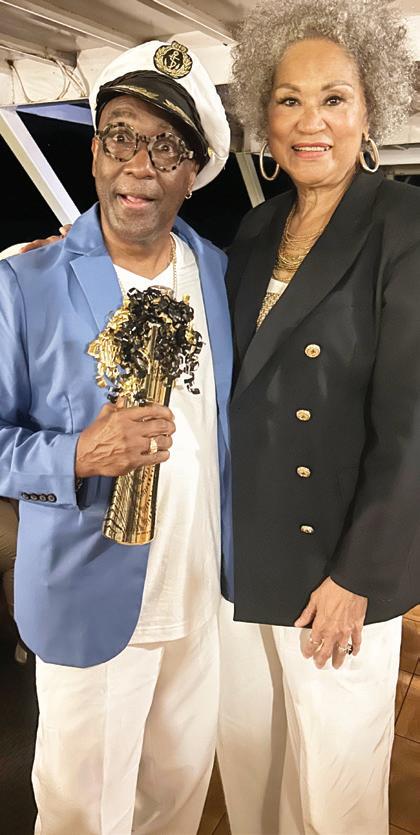
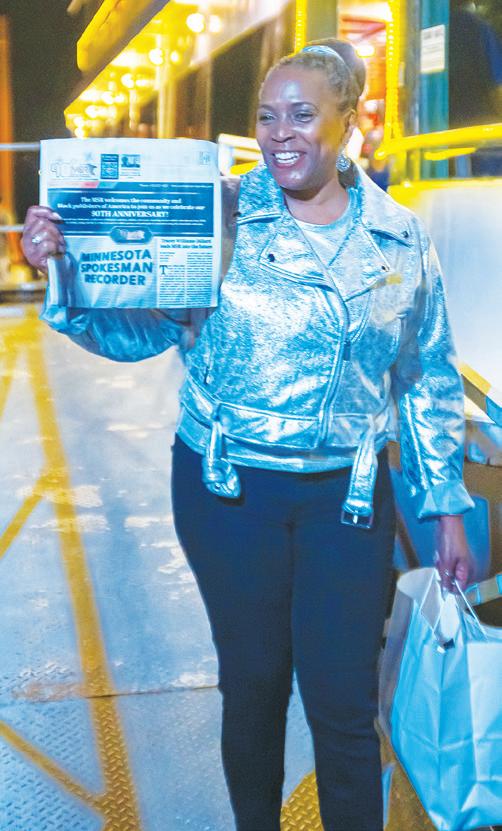
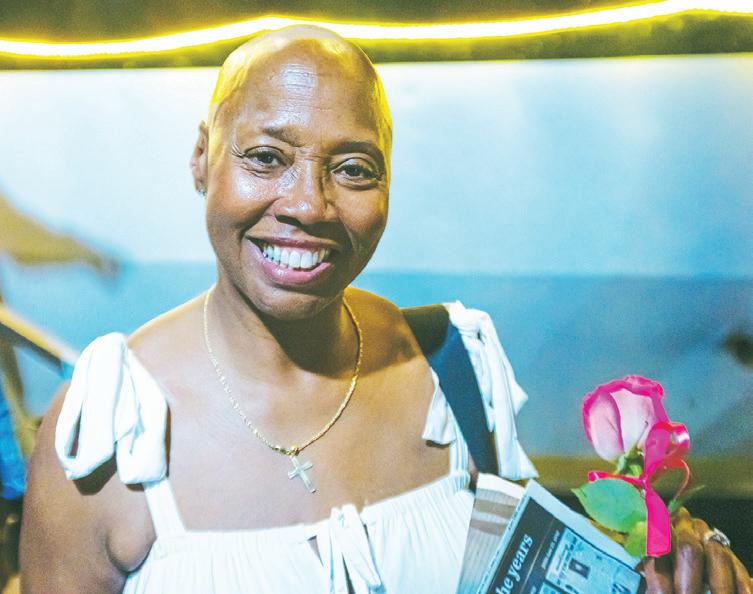
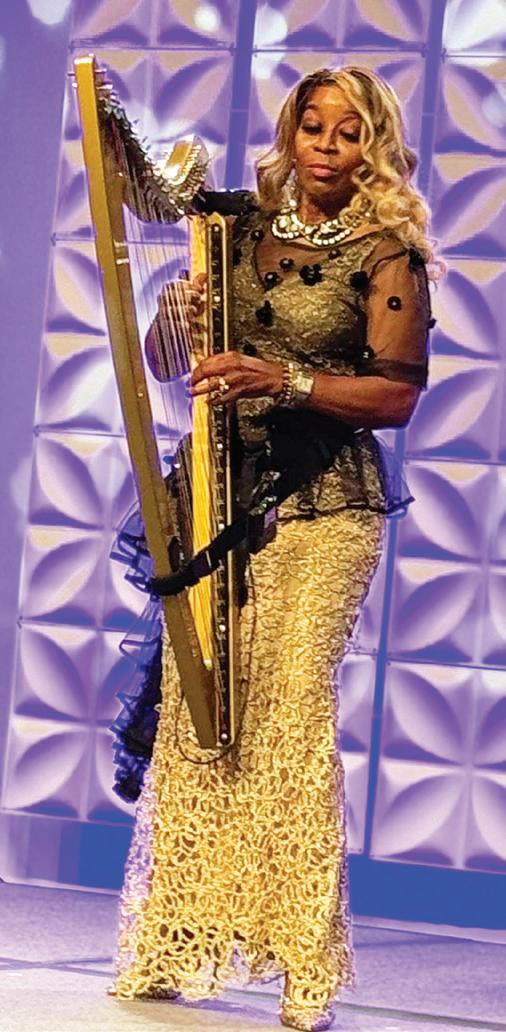
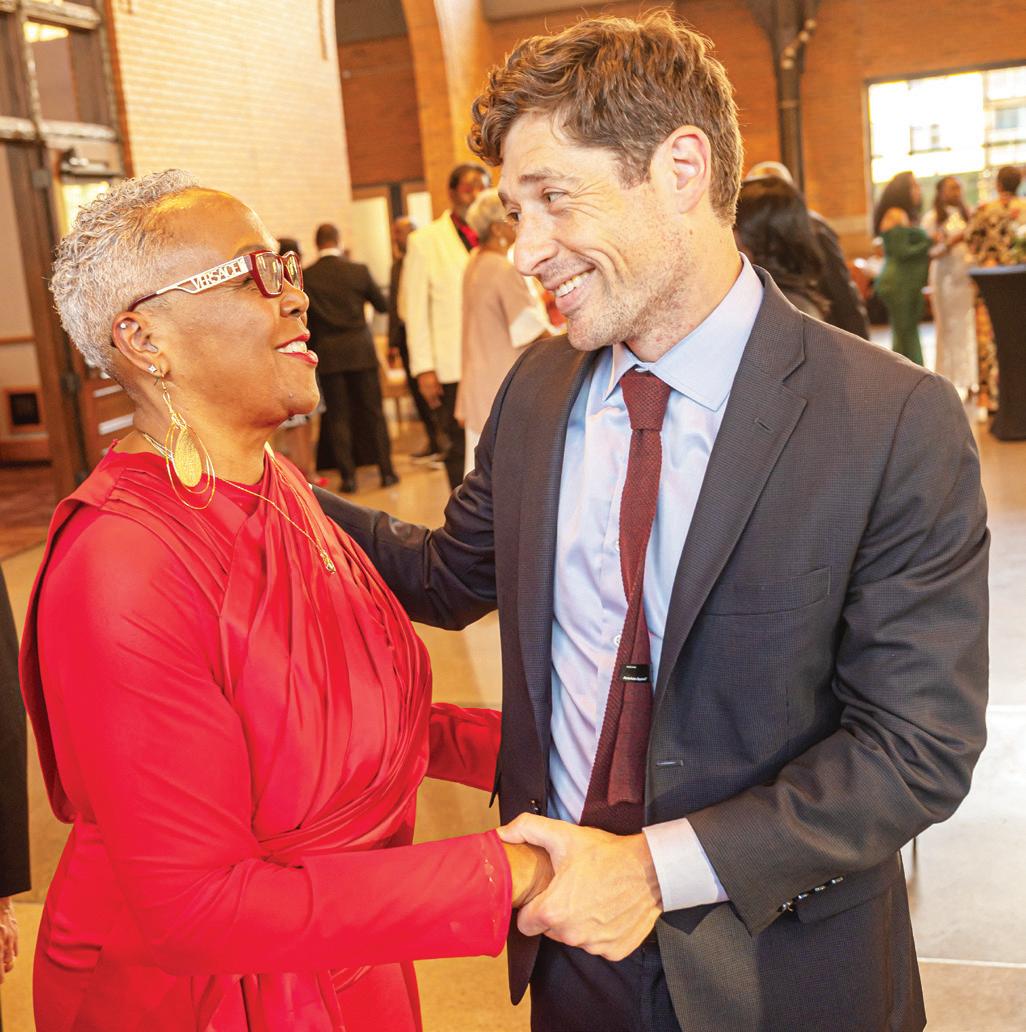


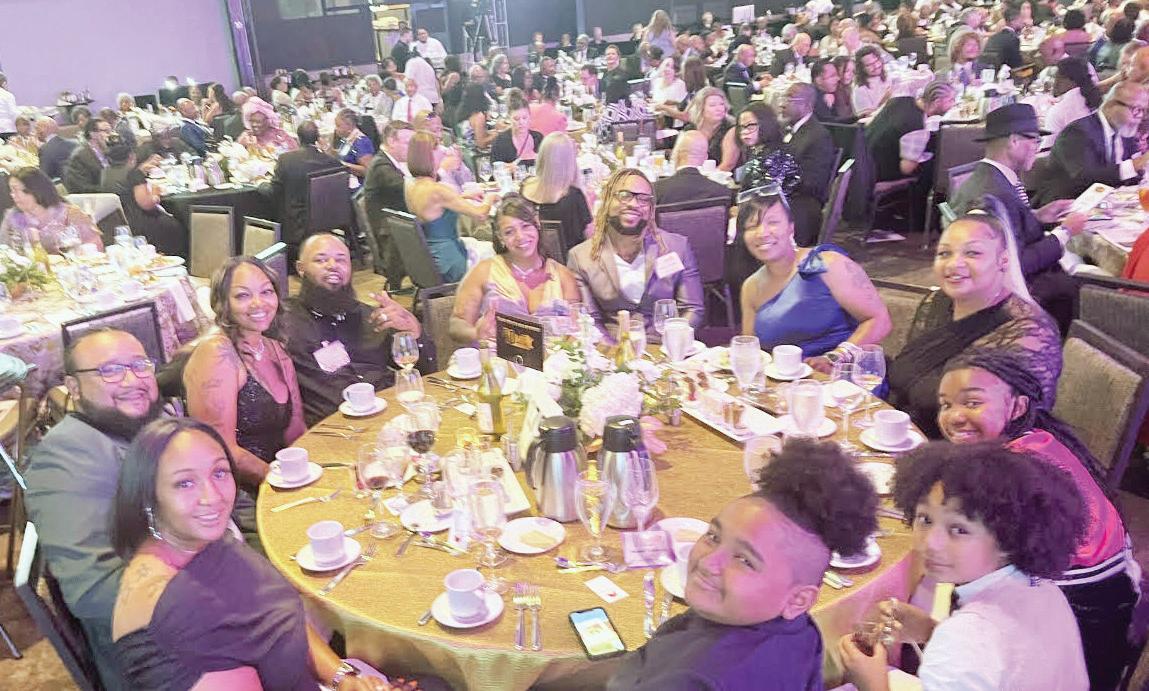
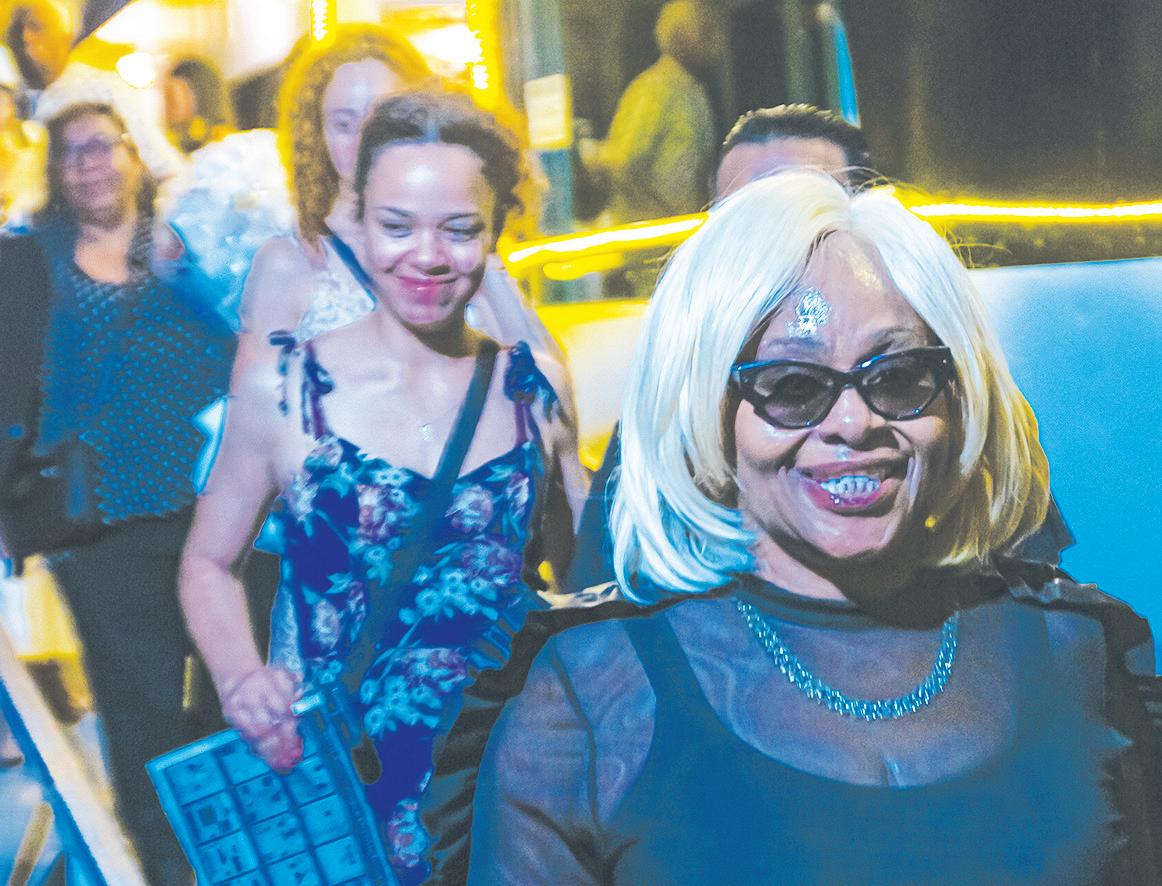


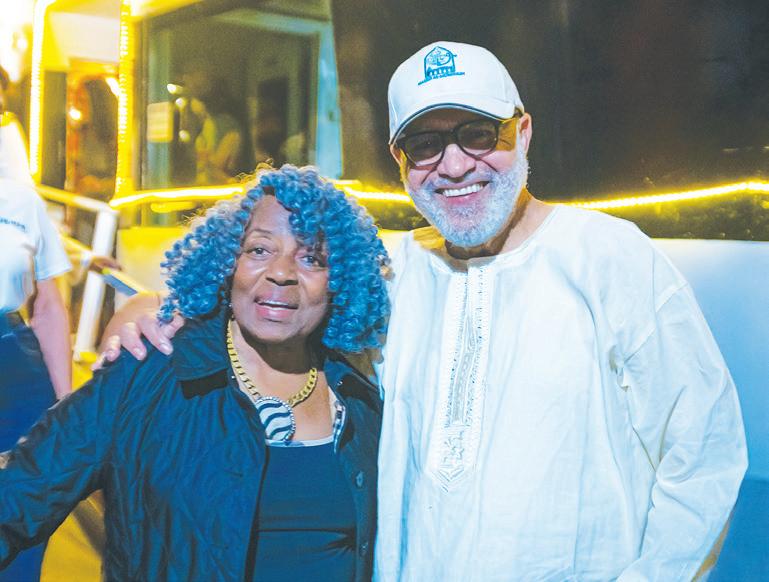
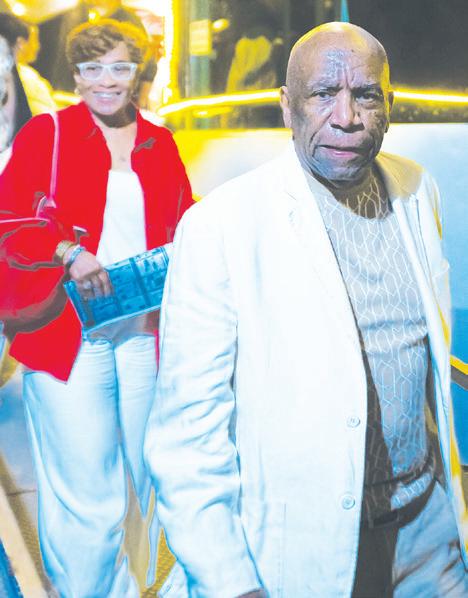
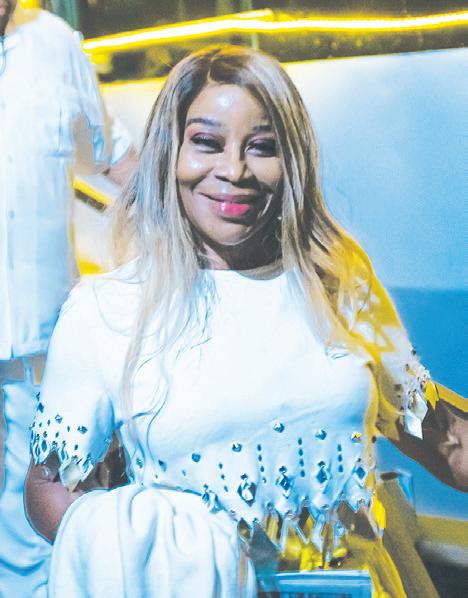
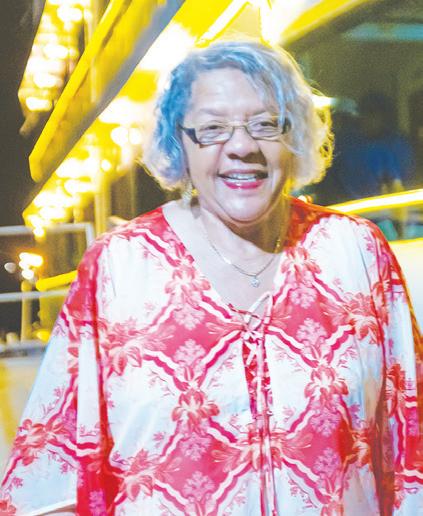
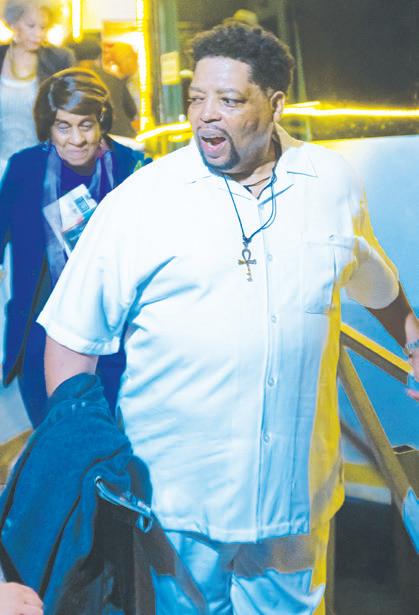
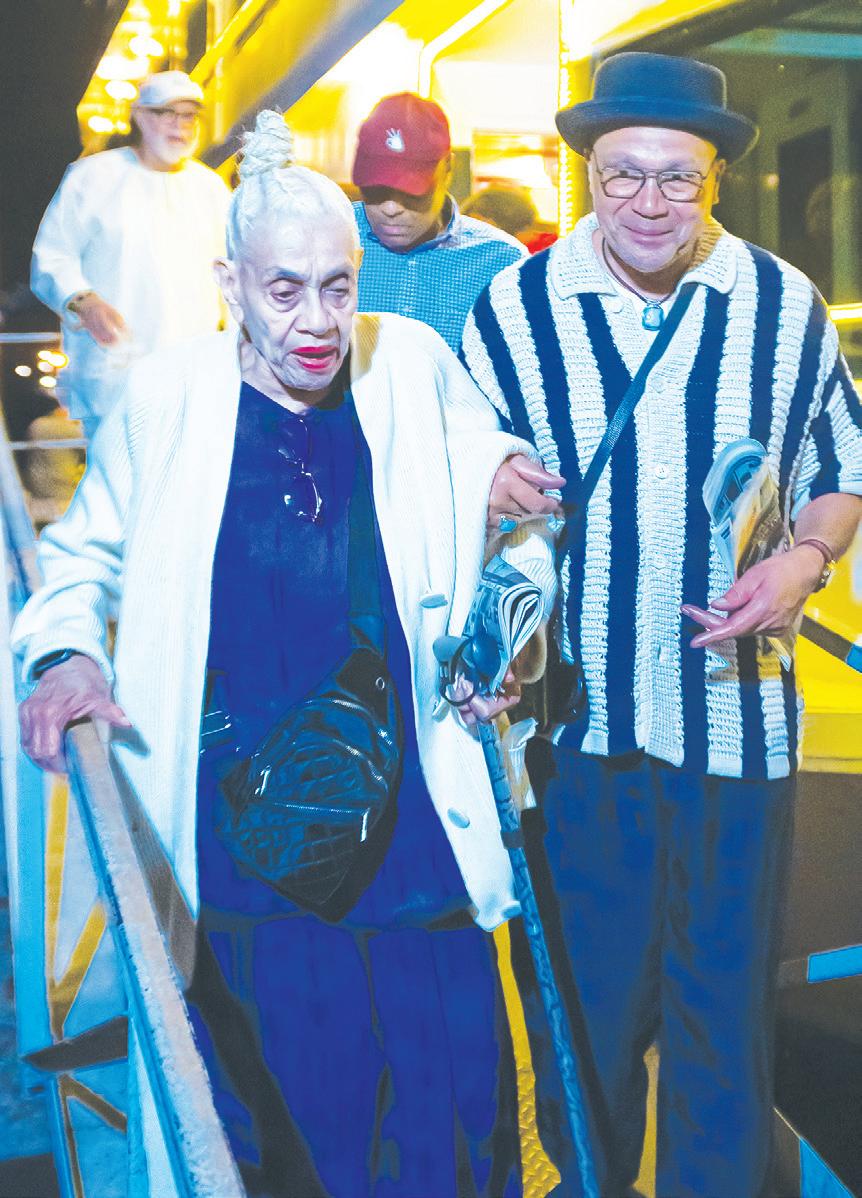
Tiana, and DJs William “BakeShow” Baker and Christopher “Godxilla” Taylor, who kept the third-deck dance floor full all night long. Not to mention Braxton herself, who, before officiating the Best Dressed contest to close the evening’s festivities, showed off her impressive vocal skills, performing two songs from her debut album “Feels So Good.”
As everyone began to disembark from the boat, the conversation was already shifting in anticipation of Saturday night’s event, the MSR’s 90th Anniversary Gala in downtown Minneapolis.
A night to remember
A few days before MSR’s celebration, WCCO-TV’s Reg Chapman and Fox 9’s Maury Glover broadcasted news stories that focused on the paper’s colossal legacy here in Minnesota and around the country while forecasting the amazing 90th Anniversary celebration weekend. Nonetheless, it’s hard to imagine that anyone could have anticipated the magic of what was in store beforehand.
Hundreds of guests, decked out in their best formal wear, began arriving early Saturday evening at the Renaissance Minneapolis Hotel-The Depot. Among them were local luminaries such as Judge LaJune Thomas Lange, Don Shelby, St. Paul City Council Member Anika Bowie, and Gary Hines.
The reception, held in the Great Northern Ballroom, hosted a silent auction and also featured the premiere of the Minnesota SpokesmanRecorder’s Traveling History Exhibit, chronicling nearly a century of the MSR and including in-depth displays that showcased, among many things, Black firsts in Minnesota; MSR legends like Gordon Parks and Carl T. Rowan; the worldwide influence of the Minneapolis Sound; the African American experience in both St. Paul and Minneapolis, and, of course, the Newman family and the three generations that have made the MSR what it has long been and remains to this day—the “voice of Black Minnesota.”
Things then moved to the Pavilion Ballroom, where Gala
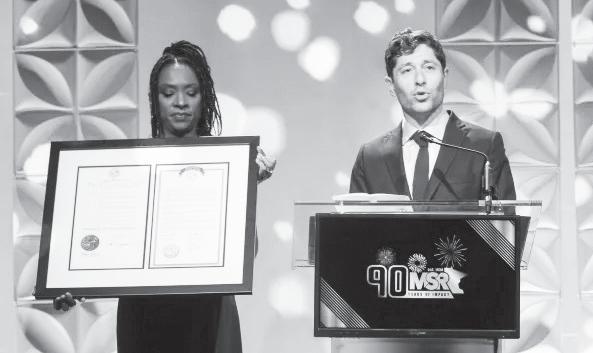
host and renowned Twin Cities journalist Angela Davis welcomed the crowd. Mayor Jacob Frey was on hand to deliver a proclamation, making August 17, 2024, “Minnesota Spokesman-Recorder Day” in Minneapolis. And St. Paul Mayor Melvin W. Carter, III, sent a heartfelt video message before guests were served an elegant dinner while listening to the genre-defying sound of internationally acclaimed harpist Mariea Antionette. She performed several of her standards, such as “Africa” and “Sekmet: The Lioness Goddess,” and covers of all-time classics by Minnie Ripperton, Luther Vandross, and Lauryn Hill. The highlights from this extravagant event are far too many to mention in the space allowed. That said, among the remarkably nice touches during the night were a series of video presentations interspersed throughout the evening where a litany of individuals, both old-school and younger attendees shared the indelible impact that the MSR has had on their lives and the larger community.
This included heartfelt messages from Twin Cities icons Robin Hickman-Winfield, Nathaniel Khaliq and Vicky Davis, Debbie Montgomery, Yusuf Mgeni, Tonya Jackman, Jack Jackman, Mary Kay Boyd, Tyrone Terrill, Michael Diehl, James L. Stroud, Jr., Craig Rice, and Aaron Abram. The latter two noted how academic scholarships from the MSR helped them attend college.
It’s a family affair
The formal program commenced when Davis invited
ing that [largely] in single-use items,” she said.
knowledge about how we can increase our stewardship of finite resources.
Our first stop was in produce, where Filsan packed away broccoli in her reusable bag instead of using plastic produce bags. “Some of the best low-waste products are fruits that peel, like bananas, oranges, and melons,” Filsan said.
Filsan openly shared why she is so deeply engaged in the sustainability of the environment and its gifts to humankind.
Williams-Dillard to the stage for an intimate interview.
Later in the evening, WilliamsDillard remarked that this Gala turned out to be everything she hoped it would be and more. She shared cherished family photos and talked more, not only about her grandfather but equally about her
whenever that may be, came on stage next and made it a point to mention the legacy of some additional footsteps she will be called on to fill one day, including those of her grandmother, the late Norma Jean Williams, and her great uncle Wallace “Jack” Jackman.
Then Davis asked recent Rock
decisions are made when you don’t have the right people in the room.”
Davis next sat down for a one-on-one interview with Dr. Chavis, who revealed other NNPA members in the room—including Black publishers from New York, Los Angeles, Baltimore, Florida, and other locales—while emphasizing the necessity for the Black Press to support one another.
Chavis also kept the audience in stitches with his wit and humor and leaked some advanced news: Beyoncé will perform on the final night of this week’s Democratic National Convention in Chicago.
“I have permission to share that with you,” he said before striking a more serious cord about the upcoming election.
“We’ve got to get the vote out in 2024. And the Black Press must lead the way. The vote is sacred to Black people in America. It’s something we’ve fought for, bled for, and died for.”

“We need to tell our stories, and those stories must be told through a certain lens.”
grandmother, the late Launa Q. Newman, who successfully ran the MSR for a quarter of a century after her husband Cecil passed away in 1976.
“There were many people out there that wanted to take the MSR from my grandmother,” she explained. “They didn’t think a woman could lead the paper. They were wrong.
“My grandmother said, ‘My husband started this paper for a reason. He knew how much it was needed. And I’m going to keep it going. Whatever it takes.’”
She also spoke of how her grandmother picked her to become her successor upon retirement, recognizing that Williams-Dillard had the “energy to keep the paper going into the 21st century.”
William-Dillard’s daughter, educator Leticia Alvarez, who is her designated replacement when she decides to retire,
and Roll Hall of Fame inductee
Jimmy Jam Harris, one half of the legendary duo Flyte Tyme Productions, to join Williams-Dillard and Alvarez on stage, where she asked him to share one of his favorite MSR memories.
“I went to Bryant Junior High School, where I first met Prince,” recalled Harris, “and I’d make the short walk after school to the MSR where my mom worked.
“This paper is part of my mom’s legacy. That’s one reason it’s so important to me.”
He then brought the audience to laughter when recounting how his birthday party at age seven in June of 1966 was featured in an issue of the paper before adding how important the MSR and the Black Press are to the world of Black music.
“We need to tell our stories, and those stories must be told through a certain lens,” said Harris. “Sometimes, the wrong
90 years of impact
Duchesne Drew, SVP of American Public Media Group, president of Minnesota Public Radio, and one-half of the power couple, including his wife and Gala host Angela Davis, delivered the evening’s keynote address. He shared just a few of the many occasions where the MSR distinguished itself, not to mention just how much the paper continues to accomplish every single issue.
Drew also highlighted the quality of journalism at the paper, citing two veteran MSR journalists: Al Brown for his coverage of the Million Man March in October 1995 and the conviction of George Floyd’s murderer, written by the late Mel Reeves in April 2021.
Observing that the MSR is every bit as important today as it was 90 years ago, Drew
concluded his presentation by stating, “Let us thank this family for their gift,” which resulted in the first standing ovation of the night.
Perhaps the most touching moment, save for William-Dillard’s closing remarks, was a dramatic reenactment of a few memorable moments between Cecil E. Newman and Launa Q. Newman, portrayed respectively by two of the Twin Cities’ most notable artistic talents, Dennis Spears and Regina Williams. The performance culminated in a duet of Nat King Cole’s “Unforgettable.”
The incomparable Shannon Paul then led the audience through the donation appeal before Williams-Dillard took the stage for the final time. She turned her attention first to the legacy of her mother, Norma Jean Williams, whom she lost only last year.
Next, she would give a heartwarming acknowledgment to her uncle, Wallace Jackman, whom she tenderly called “Uncle Jack” who served as the bridge between her and her grandmother and was the visionary who brought the MSR into the digital age.
Then, unsuccessfully fighting back tears, Williams-Dillard spoke about the MSR staff and some of the hard times the paper experienced before bouncing back. She said there were days when she was not taking home a paycheck just so her employees would be paid, and there were also times when they all went without paychecks.
“But my staff never left me,” she revealed. “They didn’t walk out.” And that is when her husband, the late Robert Dillard, whom she lost to Covid on December 19, 2020, stepped in and said, “If this paper means that much to you, I’m going to help you keep it going.”
“Robert got another job just so that I could make payroll,” she added before thanking everyone for their support of the MSR. “This is like a family reunion. I can feel the love.” Williams and Spears returned once more to reprise “Unforgettable” before the party continued with dancing and cocktails.
It was indeed a night to remember.
Tony Kiene welcomes reader responses to tkiene@spokesman-recorder.com.
“Waste is a byproduct of a system that is failing.”
Filsan showed a low-barrier step in reducing waste by reducing the amount of plastic used to wrap and carry things.
“I don’t want to harp on plastic because plastic is not the issue. Plastic was a big win for modern science. The issue is using something that will exist for hundreds of years and us-
“A lot of people think about waste as ‘I’m going to buy [stuff] and whenever I’m done with it, it will go away’ because there [seems] to be a linear [garbage] process that leaves your house but it doesn’t disappear, it goes to somebody’s backyard, somebody’s everyday living. A lot of those people are folks of color, in poor and disenfranchised neighborhoods.”
Filsan explained, “It never really goes away; it just goes away from you. Depending on whether the waste is being buried or burned, it adds a layer of harm to a neighborhood’s water or air. There isn’t a magic situation where trash just goes away.”

As an environmentalist, Filsan Ibrahim goes grocery shopping with sustainability in mind.
In its most recent report on the state of waste management, the United Nations Environment Program supports Filsan’s sentiment that we are experiencing a dire cycle of consumption and its process
through waste systems that come with a cost we are contending with—costs to human health, economies, and the environment. The cost of trying to keep up with all the trash is projected to surpass $600 bil-
lion per year by 2050.
“Waste is a byproduct of a system that is failing. When we have created our waste system, we think we need to burn it or bury it instead of finding ways to give it new life
for a cyclical system instead of extracting, using, and dumping,” Filsan affirmed.
Filsan shared some advice on pacing yourself to activate more intentional habits in what you bring into your life.
“Give yourself grace in trying to do something different from how the system or any system is functioning,” she said.
“Slow down and observe how much you take in, what you are taking in, why you are consuming what you are consuming, and then when you have an understanding of that
‘why,’ you can change however it works for you [such as] consuming less, buying less, buy things collectively with your homies, whatever it might be.
Slow down and think.”
When asked how her mom felt, Filsan chuckled. “She had to get accustomed to many things, such as composting. But now, [Mom] participates and also takes the compost out herself. She’s proud of me because [she sees] the values she instilled in me.”
Binta Kanteh welcomes reader comments at bkanteh13@ gmail.com.
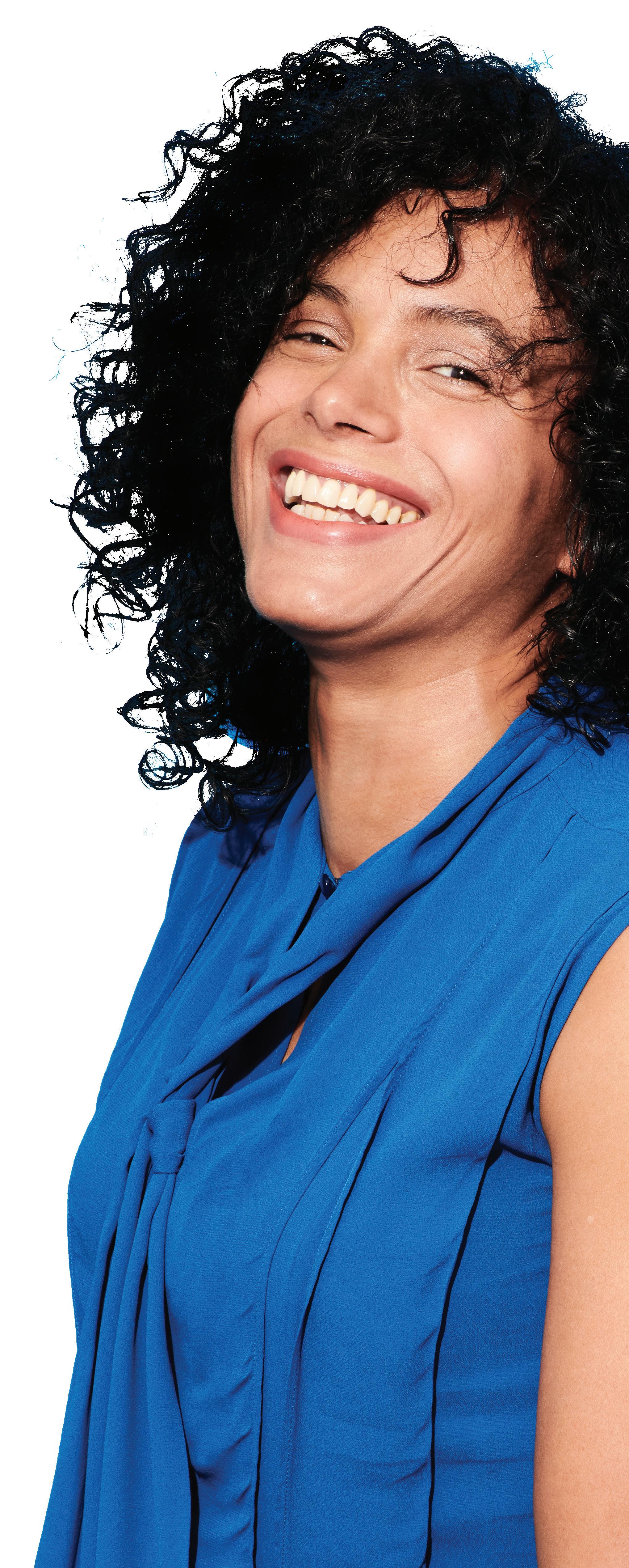
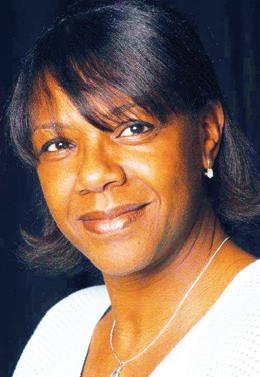
By Shandra Ward, Interior Designer
Your coffee table is more than just a place to rest your mug; it’s a focal point in your living room, a canvas for your creativity, and a reflection of your style. Whether you prefer sleek minimalism, cozy eclectic, or classic elegance, styling your coffee table can instantly elevate the ambiance of your space.
In this guide, we’ll explore simple yet effective tips to help you master the art of coffee table styling.
Start with a clean slate
Before you begin styling, clear off your coffee table
completely. This blank canvas allows you to envision different arrangements without distractions. Wipe down the surface to ensure a fresh starting point.
Consider scale and proportion
When selecting decor items, consider the size and shape of your coffee table. Vary the heights and sizes of objects to achieve a balanced look. For example, pair a tall vase with a stack of books and a decorative tray to create visual interest.
Anchor with a centerpiece
Choose a focal point for your coffee table, such as a decorative tray, a sculptural object, or a floral arrangement.
This centerpiece anchors the arrangement and sets the tone for the rest of the decor.
Layer texture and materials
Incorporate a mix of textures and materials to add depth and dimension to your coffee table display. Combine smooth ceramics with rough wood, soft fabrics with hard metals, and glossy finishes with matte surfaces for a dynamic look.


Add personal touches
Infuse your personality into the styling by incorporating items that hold sentimental value or reflect your interests.
Display cherished books, travel souvenirs, family photos, or heirloom pieces to make your coffee table uniquely yours.
Embrace negative space
Don’t overcrowd your coffee table with too many objects. Leave some breathing room around each item to allow the arrangement to breathe
and create a sense of balance.
Negative space also helps draw attention to the pieces you choose to showcase.
Play with symmetry and asymmetry
Experiment with different arrangements to find what works best for your space.
Symmetrical layouts offer a sense of order and harmony, while asymmetrical arrangements add a touch of spontaneity and whimsy. Mix and match until you find the per-
fect balance.
Refresh seasonally
Keep your coffee table decor dynamic by updating it with the changing seasons or occasions. Swap out items like candles, florals, or decorative accents to reflect the time of year or to celebrate special holidays.
Styling a coffee table is an art and a science, requiring creativity, balance, and attention to detail. By following
these tips and trusting your instincts, you can transform your coffee table into a stunning focal point that reflects your unique style and personality.
Experiment, have fun, and let your coffee table shine!
With over 30 years in the design industry, Shandra Ward brings a wealth of experience to her work. Connect with Shandra on Instagram: @shandrawardhome, visit her website at www. shandraward.com, or email her at shandrawardhome@gmail.com.


Project 2025 is Donald Trump and JD Vance’s plan to remake the federal government if they win. It would:
Use Civil Rights-era laws created to address discrimination to instead benefit white people – Axios, 4/1/24
Gut the Affordable Care Act, which will raise health care costs and threaten health care coverage for millions of Americans – AP News, 11/27/23
Cut Social Security and Medicare Americans have earned – Washington Post, 2/9/23
Ban abortion nationally – New York Times, 2/16/24


By Elizabeth Cohen
A few years ago, the organizers of one of the largest U.S. exercise programs for people with Parkinson’s disease realized they had a problem: Most of the students were white.
“We’re always asking who’s not in the room, and why are they not in the room?” said David Leventhal, program director for Dance for PD with the Mark Morris Dance Group in New York City.
Leventhal and his team went to work. They hired more instructors who spoke Spanish or Mandarin and translated marketing materials, which boosted the number of participants from Hispanic and ethnically Chinese communities. But efforts to recruit Black participants haven’t been nearly as effective, Leventhal said.
Exercise is considered fundamental to the treatment of Parkinson’s, with studies showing it can alleviate symptoms of the disease and improve mobility, flexibility and balance. But people who run Parkinson’s exercise programs in a handful of U.S. cities describe great difficulty in recruiting Black people.
“In Parkinson’s, movement is medicine. So if you’re not figuring out how to engage communities in movement, it’s basically like withholding medication,” Leventhal said. “If this were a pill, there would be an uproar.”
A small study by Yale re-
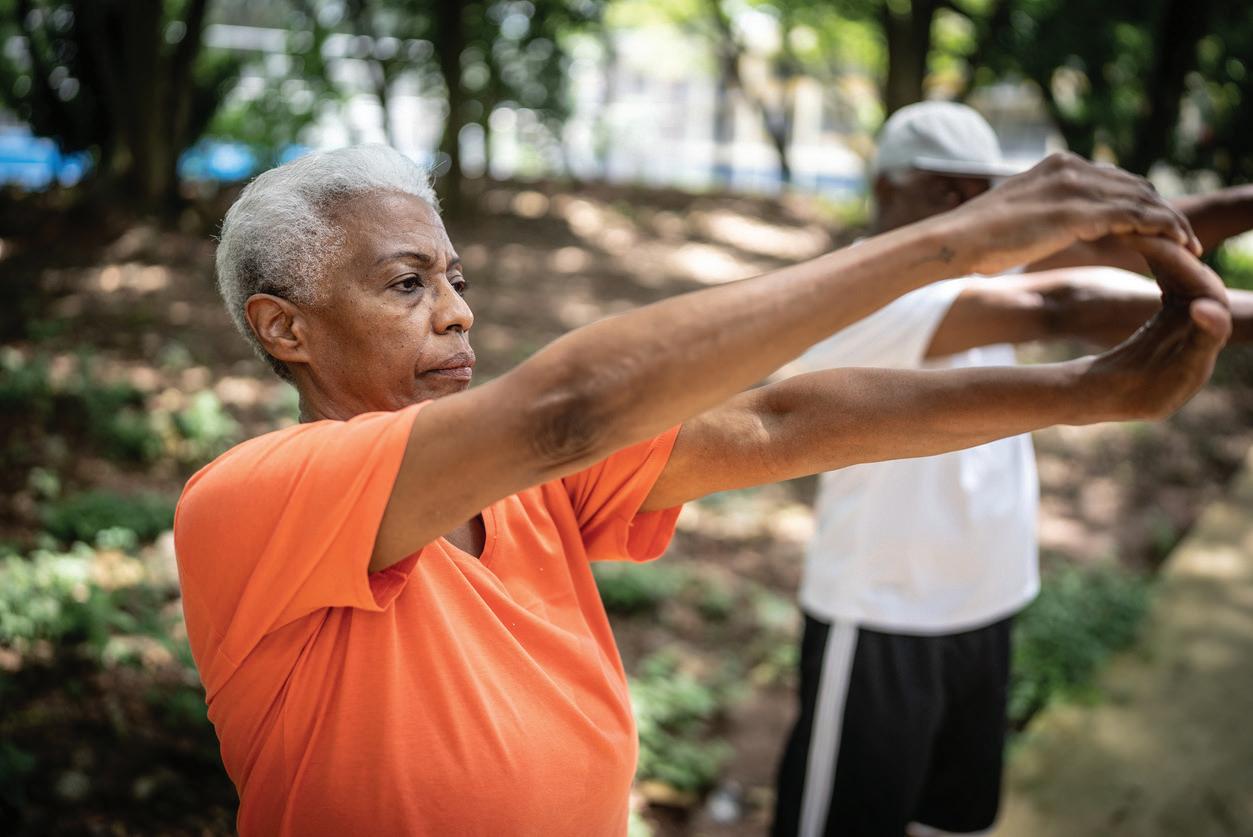
searchers showed that after six months of exercise, participants’ dopamine-producing neurons—the kind destroyed by Parkinson’s—grew healthier. Research published by a British medical journal this year encouraged a “paradigm shift” in which exercise would be “individually prescribed as medicine” to patients at an early stage of the disease.
That’s why people like Eric Johnson, founder and CEO of Movement Revolution, are frustrated. Johnson said his Chicago-area initiative offered a free six-month exercise program for Parkinson’s patients and increased marketing in the Black community but got little traction. “It was a challenge,” he said. “I’ll be honest.”
One big hurdle: Many Black people don’t even know they
have the disease. The biological and genetic risk factors have long been understudied in people of African ancestry. Recent research identified a novel risk factor for Parkinson’s in the population.
Studies show Black people are less likely to be diagnosed with Parkinson’s. Some point to doctor bias. For example, an article published last year in “Nature” concluded that bias can influence the evaluation of patients with decreased facial expressivity, a common Parkinson’s symptom in which the facial muscles harden, making it difficult to smile, raise eyebrows, and express feelings.
When a white person shows up at the doctor’s office with such symptoms, a doctor would likely recognize them
as signs of Parkinson’s, said Bernard Coley, an advocate for people with Parkinson’s disease, especially those in un-
ed unfairly or with disrespect by a health care provider in the past three years because of their race or ethnic background, compared with 3% of white adults, according to a KFF survey last year. The survey also found that six in 10 Black adults say they prepare for possible insults and feel they must be careful about their appearance during healthcare visits, while one in three white adults say they feel the same way.
Coley said that bias can lead to a delayed or missed Parkinson’s diagnosis. Then, once diagnosed, a Black patient might be reluctant to join an exercise program for fear of retribution on the job.
“You do not want to come off as sick or challenged,” Coley said, “because [your employer] will use any excuse they can to
Exercise is considered fundamental to the treatment of Parkinson’s, with studies showing it can alleviate symptoms of the disease and improve mobility, flexibility and balance.
der-engaged communities. But when a Black person has the same symptoms, the doctor might interpret their behaviors as “disconnected” or “angry,” said Coley, who’s on the board of the California chapter of the Parkinson’s Foundation.
About one in five Black adults say they’ve been treat-
get rid of you.”
Pride and privacy are other factors, said Wendy Lewis, CEO of the Parkinson Council in Philadelphia. “Black and brown families don’t share and tell their business,” she said.
“They don’t trust their story with anybody else.”
Tammyjo Best, the nurse
coordinator for the Parkinson’s Disease Comprehensive Care Clinic at Emory University in Atlanta, said that empowering Black people to lead education and recruitment is an important step toward building trust and increasing participation in Parkinson’s exercise programs. As a Black person who recruits patients for clinical trials, Best said she often overcomes mistrust.
“When they look at me, they see themselves,” she said.
After his less-than-successful efforts to recruit Black Parkinson’s patients into his exercise program in Chicago, Johnson concluded that the fact that he’s not Black is an “important factor.”
Leventhal, who runs the Parkinson’s exercise program in New York, has come to the same conclusion. His organization, the Mark Morris Dance Group, funds microgrants to groups in underserved communities to start Parkinson’s dance programs so that “they can become the holder of the purse and the puller of the purse strings, and they’re making those financial decisions on their own.”
Elizabeth Cohen is a medical correspondent for the CNN Medical News Unit and a contributing writer at KFF Health News, a national newsroom that produces in-depth journalism about health issues, an independent source of health policy research, polling, and journalism.

Sponsored by

Credit cards can be an important tool for building a healthy financial future. When used responsibly, credit cards can help you establish a solid credit history, making it easier to finance larger purchases—like a home or vehicle—in the future.
You can still qualify for a credit card even if you don’t have a strong credit history. JPMorgan Chase explains how to apply for a credit card, what to look for in a credit card, and how credit cards can help you achieve your future financial goals.
How do I get started?
If you already have a checking or savings account in good standing, consider applying for a credit card at your current bank. You can apply online or visit a bank branch to work with a representative. Make sure to ask about all their credit card options.
You can also apply for a card online through any financial institution.
Wherever you apply, you’ll usually need to provide your Social Security number or an individual taxpayer identification number, source(s) of income, and evidence of monthly housing or rent.
What should I look for in a credit card?

credit limits.
If you don’t qualify for a regular credit card, consider starter credit cards for those new to credit, including:
• Student credit cards. These cards are usually designed for students who have never had a credit card before and are looking for helpful benefits like no annual fees.
• Store credit cards. Retailers can approve applicants with little credit history for a card. Store cards usually carry a higher interest rate, but payments still become part of your credit profile. Remember to try to pay off the balance each month to help avoid raking up interest.
You can also ask to become an authorized user on someone else’s card. If the other person makes their payments on time, that will also be reflected on your credit report.
Get good credit with credit cards
You may find it helpful to find a card with no annual fee, so you don’t have to pay money out of pocket just to carry the card. You may want to make sure your credit card issuer reports to all three credit bureaus. This way, you can build credit history across the board and improve your chance of getting future credit cards and loans.
How can I use credit cards to build credit?
There are multiple ways to use credit cards to help establish credit and increase your credit score.
There are multiple ways to use credit cards to help establish credit and increase your credit score. Make your payments on time and avoid “maxing out” your card—maintain a low balance by keeping your credit usage below 30% of your card’s limit. Time is the best way to build credit history, so make sure you keep your credit card account open even if you don’t use the actual card much.
What if I don’t have a credit history? While this likely won’t block you
from getting a credit card completely, it can affect the types of cards and terms you’re approved for.
Card issuers consider factors like your credit score, income, and employment. Your credit history heavily influences your credit score, so if you don’t have a credit history, your card may come with higher interest rates. You might also have a lower credit limit because you haven’t yet proven you can pay back money on time.
Eventually, you can build a strong credit history through on-time payments, which may make you eligible for lower interest rates and higher
Applying for and using a credit card responsibly can be a step toward building a solid financial future. As you establish your credit history, you can use tools like Chase Credit Journey to check and monitor your credit so you can stay on track toward your financial goals.




It’s that time of year when the National Endowment for the Arts announces its NEA Jazz Masters—and they’ve done just that for 2025.
The newest recipients will be honored on April 26, 2025, at the John F. Kennedy Center for the Performing Arts in Washington, D.C.
Those receiving the fellowship—the nation’s highest honor in jazz include Marilyn Crispell, Marshall Allen, Chucho Valdes, and A.B. Spellman NEA Jazz Masters Award for Jazz Advocacy Gary Giddens. Each recipient will receive an award of $25,000.
“We are delighted to welcome these four luminaries to the ranks of NEA Jazz Masters—they have each, in their unique way, played a crucial role in the nurturing and development of this art form and demonstrate the immense di-

versity and creativity found in jazz today. We look forward to working together with the Kennedy Center on events next April that will celebrate their achievements and inspire new audiences and musicians to embrace jazz,” NEA Chair Maria Rosario Jackson, PhD, said. More information on the concert will be made available next year. Visit arts.gov for bios and selected discographies of the 2025 NEA Jazz Masters. Nomi-
nations for the next class of honorees is October 31, 2024.
Young singing sensation Samara Joy announced that she’ll return on tour with her family this December. More dates are to come, so stay tuned. If you follow her on X, you would have seen her recent post, “Jazz on the Vineyard,” with photos of her band with Barack and Michelle Obama. She also posted a video from her performance at this year’s
Newport Jazz Festival, which is always held in August. Hopefully, Joy will be invited back to the Twin Cities this winter.
But hold on, the summer isn’t over yet. The 2024 Chicago Jazz Festival is from Thursday to Sunday, Aug. 29—Sept. 1. It’s free!
The festival is a Labor Day weekend tradition that features local, national, and international artists. This year’s line-up features the Billy Harper Quintet, Catherine Russell,
James Brandon Lewis, Rene Marie & Experient in Truth, Kenny Garrett and Sounds
From The Ancestors, Sharel Cassity Alliance, Jason Palmer Quartet, Orrin Evans, and the Spanish Harlem Orchestra, among others. It’s been a while since I’ve made the trip to Chicago, but I’d consider taking a road trip this year to see these outstanding artists and experience their musical brilliance in an exciting outdoor setting.
In jazz, everyone is talking about the previously unreleased live album Wayne Shorter: Celebration, Volume 1, which comes out on August 23 on Blue Note Records. The recording features Shorter’s celebrated quartet from 2014.
The legendary saxophonist and composer passed away on March 2, 2023. The album is the first of a new series of planned Shorter releases. In other words, expect even more fireworks.
I might be late to the party, but I recently discovered The Bahama Soul Club, a German-
based group with a unique blend of soul, jazz, funk, blues, bossa nova, afro, and Caribbean influences. I recommend listening to the album Bohemia After Dawn, released in 2020, as I did. On August 15, we celebrated pianist Oscar Peterson’s birthday. Often called “the Maharaja of the keyboard,” his unique virtuosic technique made him one of the world’s most influential jazz pianists of the 20th century. Jazz bassist and composer Stanley Clarke has new music coming out soon, so it’s good he is coming to the Dakota with his band on August 29 & 30. On September 30, the Travis Anderson Trio presents the music of George Gershwin, and vocalist Kurt Elling with pianist Joey Calderazzo performs on September 7. All are quality shows that are not to be missed. For tickets, please visit www.dakotacooks.com.
Robin James welcomes reader comments at jamesonjazz@ spokesman-recorder.com.
By Abdi Mohamed Associate Editor
Renowned Hip-Hop artist and writer Mic Crenshaw has spent recent years reflecting on his youth growing up in Minneapolis, where he spent time with a large group of young adults between their late teens and early 20s attending punk shows, discussing Marxism, and fighting Nazis.
Crenshaw was a part of the Baldies, a group of punk rock-loving teens who donned shaved heads and Doc Martin boots that identified as skinheads, reclaiming the term that had been associated with white supremacy and hate. The Baldies believed that the true meaning of being a skinhead was rooted in British workingclass culture that was inherently anti-Fascist in its origin.
Whether it was in parking lots and concert venues, the Baldies would confront any white supremacy-related groups in person and respond with the same violence that they had threatened Black and Brown people. Crenshaw’s experience with the Baldies has been documented in the
book “It Did Happen Here: An Antifascist People’s History.” It would then inspire a podcast with the same title later on.
Although Crenshaw had been a successful touring music artist for decades at the time, he didn’t consider himself a literary writer. He first entered into his book deal with PM Press in 2010. For a while, he was self-conscious
“If we weren’t in the streets ourselves, we’re close to people who were in the streets engaging these far-right elements.”
about his writing.
“I think part of that was like fear of failure and imposter syndrome, like me not being able to imagine myself as a writer,” Crenshaw said. While working with his publisher, Crenshaw traveled back to Minnesota to interview some of his old friends.
“I submitted the outline of my book to PM Press, and it
was all about me, and they said this is great, but you should interview other black skinheads.”
While researching his book, Crenshaw was approached by his friend Erin Yanke, who asked if he’d consider lending some of his work and interviews for a podcast.
The pair had access to funds through a radio station they both worked at. They put a proposal together to produce a podcast that highlighted the early experiences that Crenshaw and his peers went through while fighting NeoNazis on the front lines.
They released their first episode of “It Did Happen Here” in late 2020 through Portland’s KBOO FM. The show was hosted by Yanke, Crenshaw, and Celina Flores, where they discussed the tension and violent clashes between anti-racist and anti-Fascist groups who went up against Neo-Nazis in the 80s and 90s.
Several others on the production team were what Crenshaw described as conscious people, most of whom identified as being radically left politically.
“Even within that, there’s a

fascists and racists in check.
“If we weren’t in the streets ourselves, we’re close to people who were in the streets engaging these far-right elements,” he said.
When asked what led him to draw on his past and share his experiences with people today, Crenshaw stated that the lessons of the past could still be applied to the issues facing people today. Realizing this, he and his friends felt confident sharing their stories on different platforms, knowing that a broader audience would be interested in these conversations.
pretty diverse spectrum, but some of the things we had in common was a background in social movements for social change and subcultures,” he said.
lying force in the United States of America, but we watched it kind of proliferate and escalate under Obama as a form of cultural backlash, and then in the Trump years, it got even more heightened,” he described.

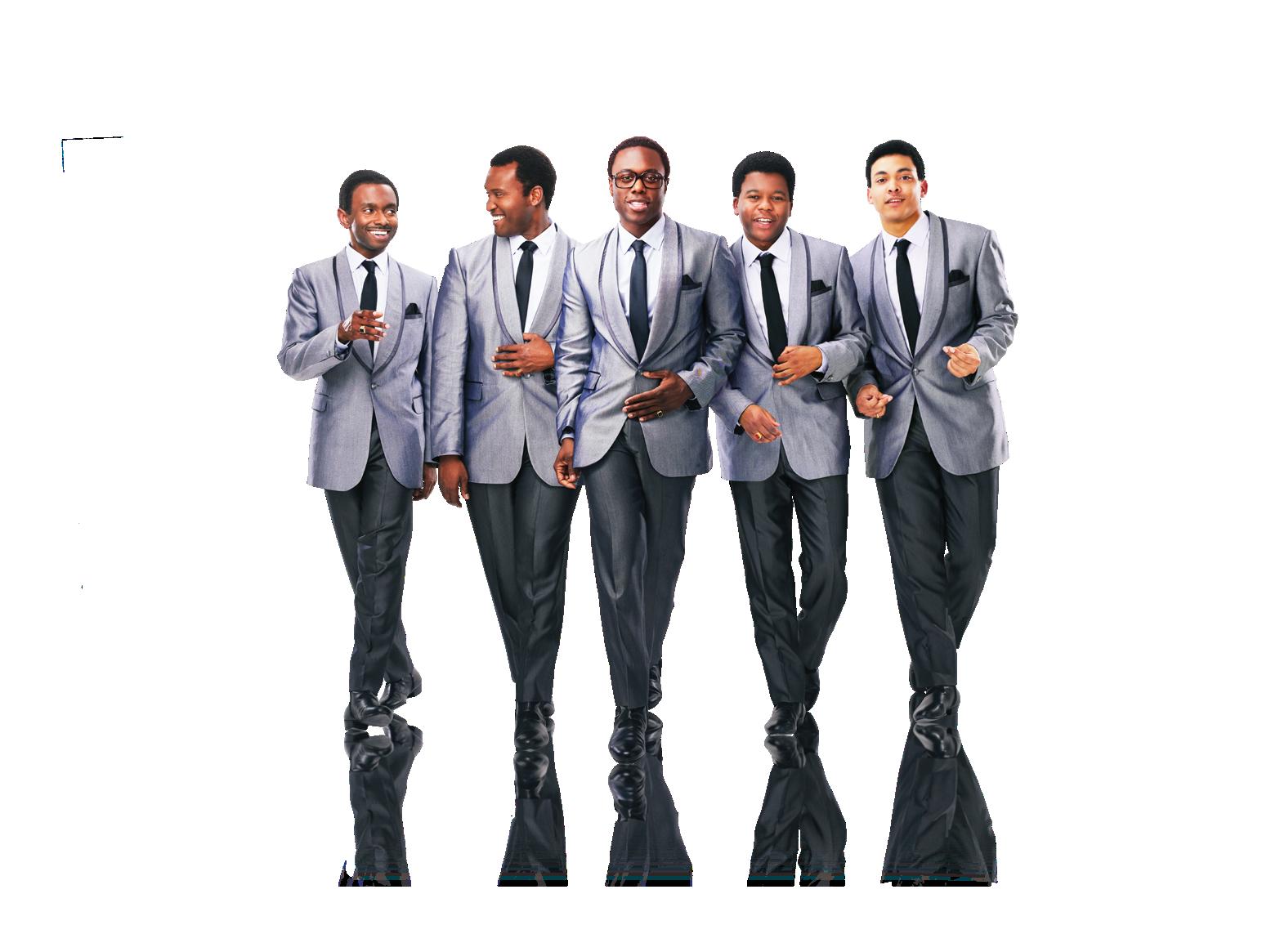
Over the years, Crenshaw and his peers from similar antiracist organizations kept keen on the developments of the far right, especially in Portland, which became a flash point for clashes. They witnessed a resurgence of action from white supremacist groups during the Obama years as the nation witnessed its first person of color ascend to the presidency.
“It’s always been like an under-
Crenshaw has long given up his direct action efforts where he would engage farright elements in the street and turned to music as his preferred outlet. However, he and his friends, who have already earned their stripes and keep their ear to the ground on these issues, have now looked to the next generation to keep
When reflecting on his years with the Baldies and other anti-fascist organizations, Crenshaw is grateful that he connected with so many people who aimed to do good work. However, as he looks back, he remembers how consequential things were at the time, making him more aware of how some similar elements are around today.
“I think there were times when one could look at the proliferation of our movement and be proud, but that came later. We felt like we were facing a potential tidal wave. A threat to our existence, so we had to do everything we could,” he said.
Abdi Mohamed welcomes reader comments at amohamed@ spokesman-recorder.com.



As the Minnesota Spokesman-Recorder approaches its 90th anniversary, you’re invited to commemorate this historic milestone by donating $90 to celebrate 90 years of continuous publication.
As the Minneapolis Spokesman-Recorder begins its 90th Anniversary year, you’re invited to commemorate this historic milestone by donating $90 to celebrate 90 years of continuous publication.
Your generous contribution will support our legacy of dedicated community empowerment through journalism and ensure our vital work continues into the future.
As a “$90—for- 90” contributor (non-business), your name will be prominently displayed in our print and digital editions until the week of Aug. 10, 2025. The paper was founded on Aug. 10, 1934.
As a “$90-for-90” contributor (non-business), your name will be prominently displayed in our print and digital editions until the week of Aug. 10 — the date of our founding in 1934.
Please consider this unique opportunity to stand collectively with the MSR, honoring 90 years of tradition and community service. For inquiries or to join as a “$90-for-90” supporter, call 612-827-4021, visit our website, or email admin@spokesman-recorder.com.
Anita Alexander
Ray Seville Productions
Torrion Amie
Kimerlie Geraci
Holly Andersen
David Fettig
Jonathan Beck
Tracy Wesley
Clara Boykin & Family
The O’Neill Family
Gretchen Bratvold
Liam Cavin
Amanda Brinkman
Your Name Here
Toweya Brown-Ochs
Your Name Here
Benjamin F. Bryant & Dr. Antusa S. Bryant
Your Name Here
Deanna Callender
Shirlee L. Callender
Your Name Here
Liam Cavin
Your Name Here
Janis Clay
Your Name Here
Edward Coblentz
Your Name Here
Michael Davis
Your Name Here
Victoria Davis
Your Name Here
Michael Diehl
April A. Estes
Your Name Here
George Ewing
Your Name Here
Elizabeth Fealey
Your Name Here
David Fettig
Your Name Here
Readus Fletcher
Your Name Here
Ken Foxworth
Your Name Here
Michael Franks
Your Name Here
Lee Friedman
Your Name Here
Ella Gates-Mahmoud
Your Name Here
Your Name Here
Kimerlie Geraci
Erick Goodlow
Your Name Here
Leota Goodney
Your Name Here
Pamela Hall-Clemens
Your Name Here
Hendon Group, Inc
Your Name Here
Colnese Hendon
Your Name Here
Connie Hudson
Your Name Here
Angelo Hughes
Katie Izzo
Your Name Here
Nina Johnson
Your Name Here
Clarence Jones
Your Name Here
Debra Jones
Your Name Here
Cynthia Kelly & Murry Kelly Jr.
Your Name Here
Nathaniel Khaliq
Your Name Here
Zena Kocher
Your Name Here
Jimmy Lewis
Your Name Here
Lisa Lissimore
Michele Livingston
Your Name Here
Harlan Luxenberg
Your Name Here
MRPP and Associate Communications
Your Name Here
Melanie Manaen
Your Name Here
Kyle Meerkins
Your Name Here
Deborah Montgomery
Your Name Here
Debbie Morrison
Your Name Here
Marcia Murray
Your Name Here
Mary K. Murray Boyd
Your Name Here
Dan Ness
The O’Neill Family
Your Name Here
Liz Oppenheimer & Jeanne Burns
Your Name Here
Ray Seville Productions
Your Name Here
Mary Quinn McCallum
Your Name Here
Amy Pfankuch
Your Name Here
Patty Ploetz
Your Name Here
Mark Ritchie
Your Name Here
Lyn Rabinovitch & John Saxhaug
Your Name Here
Augustus Ritemon
Your Name Here
Carolyn Roberson
Your Name Here
St. Paul Saints
Your Name Here
Floyd Smaller
Your Name Here
Chanda Smith Baker
South Hill Film
Your Name Here
Ronald Spika
Your Name Here
Timothy Sullivan
Your Name Here
Heidi Swank
Your Name Here
Dotty Timmons
Nicholas Upton
Your Name Here
Jason Walker
Your Name Here
Dr. Betty Webb
Your Name Here
Bill Wells
Your Name Here
Tracy Wesley
Your Name Here
Jeffery Young
Your Name Here
Your Name Here
Your Name Here
Your Name Here
Your Name Here
Your Name Here
Your Name Here
Your Name Here
Your Name Here
Your Name Here
Your Name Here
Your Name Here
Your Name Here
Your Name Here
Your Name Here
Your Name Here
Your Name Here
Your Name Here
Your Name Here
Your Name Here
Your Name Here
Your Name Here
Your Name Here
Your Name Here
Your Name Here
Your Name Here
Your Name Here
Your Name Here
Your Name Here
Your Name Here
Your Name Here
Your Name Here
Your Name Here
Your Name Here
Your Name Here
Your Name Here
Your Name Here
Your Name Here
Your Name Here
Your Name Here
Your Name Here
Your Name Here
Your Name Here
Your Name Here
Your Name Here
Your Name Here
Your Name Here
Your Name Here
Your Name Here
Your Name Here
Your Name Here
Your Name Here
Your Name Here
Your Name Here
Your Name Here
Your Name Here
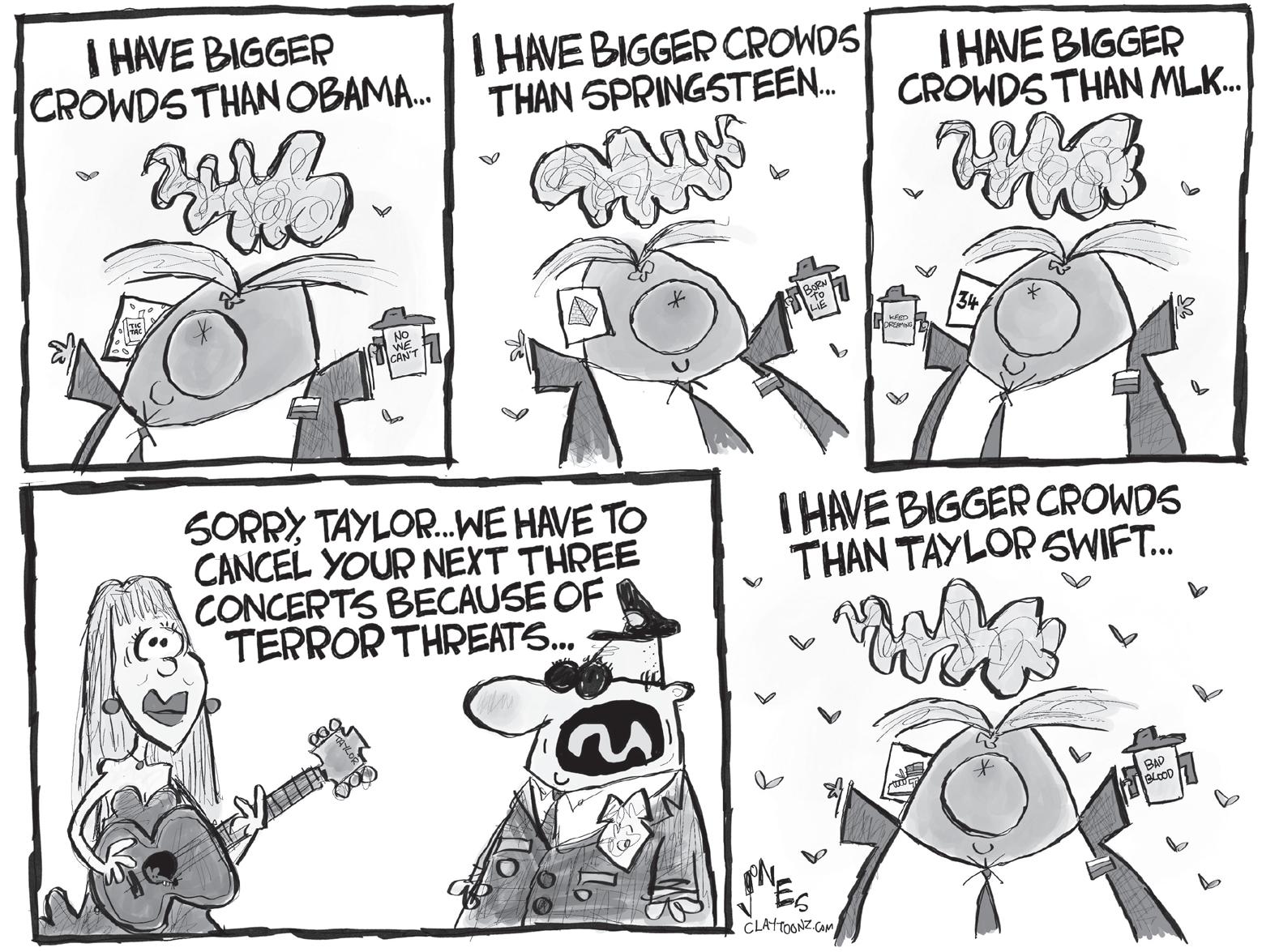
By Liz Courquet-Lesaulnier
When news broke on Aug.
10 that Jordan Chiles was being stripped of her Olympic bronze medal, supporters of the 23-year-old gymnast reacted with serious “We ride at dawn” energy. Understandably so.
Just five days earlier, people worldwide had celebrated an unprecedented moment: Olympic gymnastics’ first allBlack champions’ podium. We watched Chiles stand proudly alongside her American teammate, silver medalist Simone Biles, and Brazilian gold medalist Rebeca Andrade. Videos and photos of the powerhouse trio captured the best of Black sisterhood.
Now Chiles’ historic achievement has been tainted by both the decision to grant her medal to a Romanian competitor—due to judging errors during the competition—and the relentless, racist harassment Chiles has been subjected to since then.
“While celebrating my Olympic accomplishments, I heard the devastating news that my bronze medal had been stripped away,” Chiles posted on Instagram.
“I have no words. This decision feels unjust and comes as a significant blow not just to me but to everyone who has championed my journey,” she wrote.
“To add to the heartbreak, the unprompted racially driven attacks on social media are wrong and extremely hurtful.”
How did we get here?
On Aug. 5, after finishing in fifth place in the floor exercises
competition, Chiles’ coaches successfully appealed an error that had initially undervalued one of her jumps. The correction boosted her to third place and the bronze medal.
Five days later, however, the decision was reversed:
The Romanian team, whose gymnast had initially won the bronze, argued to the Court of Arbitration for Sport that Chiles’ coaches submitted their inquiry four seconds past a one-minute deadline.
The court sided with Romania and took Chiles’ bronze away on essentially a not-atall-clear technicality.
sentiment of many Black people on social media is something like this: They can’t stand to see Black women win.
From the moment the Romanian gymnast spilled whitewoman tears after Chiles replaced her on the winner’s podium, racists on social media turned their outrage on Chiles. They called her the n-word online and in DMs to her family. They said she didn’t deserve a medal. They used A.I. to create cruel, degrading images of her—including depicting Chiles as a monkey.
By William Cooper
The race to define Kamala Harris is now well underway. According to Donald Trump and the Republicans, the Democrats’ new champion is “a bum” and “a failed vice president.”
Democrats, meanwhile, hail Harris as the leader of a “fight for the future” and the only thing standing between America and MAGA authoritarianism.
Presidential campaigns, of course, deal in caricatures and exaggerations. And neither side gets it right. So who, exactly, is Kamala Harris?
She can be defined most clearly by who she’s not.
First, she’s not Barack Obama. She doesn’t have the former president’s charisma or natural connection with voters. Obama filled stadiums and inspired millions with the power of his message and the flare of his speeches. He was a transformative presidential candidate. Harris is not.
She isn’t the leader of a great movement, nor does she inspire the multitudes with her riveting oratory. Compared to Obama, she’s rather underwhelming. But she is an astute politician who has succeeded at the local, state and national levels.
With the Democrats’ entire machine coalescing around her, this seems likely. Her favorability ratings have materially jumped since she entered the race.
discord likely in another Trump term, that doesn’t just make her a solid presidential candidate. It makes her a compelling one.
Second, Harris is not Joe Biden. She doesn’t have the current president’s policy background or deep federal government experience. Biden entered the Senate in 1972 when Harris was six years old.
If Harris isn’t a generational political talent or a great leader of women and men, she’s exponentially better than the alternative.
But she’s not a government neophyte, either. She was San Francisco’s district attorney, then California’s attorney general, then a United States senator, and now the vice president. If elected president, she will likely put together a strong cabinet. She’s been a mainstream Democrat for years and will surround herself with seasoned leaders from within the party.
Indeed, contemporary American politics is rarely about championing your ideal candidate or favorite policy proposal. Far more often, it’s about discerning your leastworst option. And even if Harris isn’t a generational political talent or a great leader of women and men, she’s exponentially better than the alternative.
Harris, an African American of South Asian descent, would be the first woman president—an astounding personal achievement and momentous national step forward. But she is, at her core, a traditional Democratic politician. She’s not a rock star (like Obama), way too old (like Biden), or a wannabe dictator (like Trump). She’s smart, experienced and focused. And if she wins in November, she will give America what it needs most from its president: a reversion toward the mean.
But here’s where things get extra murky: The U.S. team subsequently presented video evidence showing that the inquiry was, in fact, submitted 20 seconds before the 60-second deadline. Yet the Olympic committee refused to reconsider the decision, arguing that the new evidence came too late.
This isn’t just about a medal, though. This is about how the rules are applied—and to whom. To many folks, seeing a white competitor defeat a Black woman over a four-second delay feels like more than just a mistake. The overriding
The overriding sentiment of many Black people on social media is something like this: They can’t stand to see Black women win. submissions@spokesman-recorder.com submissions@spokesman-recorder.com submissions@spokesman-recorder.com.

Adding insult to injury, “right-wing (social media) personalities and racists,” as Vox wrote, began “peddling narratives about how the Olympics cheated white gymnasts out of medals, or saying that Black athletes like Chiles are cheaters themselves.”
On Aug. 9, Jordan’s mother Gina Chiles posted on X, formerly known as Twitter—doing what any Black mom would do: coming to her daughter’s defense. “The racist disgusting comments are still happening in 2024,” Gina Chiles wrote. “I’m tired of people who say it no longer exists.”
Right on cue, the “rules are rules” crowd insisted that the arbitration court’s decision to take away Chiles’ bronze medal had nothing to do with the race. But here’s the thing: Jordan Chiles didn’t lose her medal because she faltered in her performance. She didn’t miss a step, fall off the beam, or misjudge a landing.
Her medal was stripped from her over four seconds— an alleged delay that her team has proven didn’t exist.
On Aug. 11, Jordan’s sister Jazmin wrote on Instagram that Jordan, who also won gold in Paris, doesn’t deserve this treatment. Her sister proudly represented her country on the world stage. It’s proof, she says, that Black people, and especially Black women, are treated differently.
“Racism is real, it exists, it is alive and well,” she wrote.
In Feb. 2022, the powerhouse gymnastics team at the University of California-Los Angeles—where Chiles began competing that fall—was rocked by a scandal in which a white gymnast allegedly called a Black teammate the n-word.
As I wrote then, “The ability to win has never protected Black athletes from racism.” In fact, people sympathized with the white gymnast when she complained her Black teammates were intimidating her.
In the meantime, folks have rallied around Jordan, posting on social media that she’ll always be “that girl,” forever a champion. “Jordan Chiles,
While her first presidential campaign was embarrassingly disorganized, if her team stays focused this time around,she will be a strong candidate.
Finally—and most importantly—Kamala Harris is not Donald Trump. She’s not a shameless propagandist who traffics in personal grievance and constitutional illiteracy. Nor has she tried to reverse a presidential election. And she’s now Trump’s only alternative for the presidency.
Given the domestic dysfunction and international
William Cooper is the author of “How America Works … And Why It Doesn’t.”
By Kim Smith
As the world grapples with the ever-intensifying impacts of the climate crisis, a stark and troubling reality has emerged: Black communities are bearing a disproportionate burden of environmental degradation.
This inequity is not merely a matter of statistics or abstract concepts; it translates into real, tangible hardships that exacerbate existing social and economic disparities. Historically, Black communities have been subjected to systemic neglect and discrimination, and climate change is amplifying these injustices.
From heatwaves to hurricanes, the effects of climate
This discrepancy is more than an inconvenience—it has serious health implications. Extreme heat can exacerbate conditions such as asthma, which disproportionately affects Black children, and contribute to higher mortality rates.
Moreover, climate change amplifies the risk of extreme weather events, such as hurricanes and floods. Communities that are already marginalized face the brunt of these disasters, not only because they are located in more vulnerable areas but also because they have limited resources to prepare for or recover from such events.
First and foremost, public transit offers a direct solution to reducing greenhouse gas emissions.
change are not felt equally across all demographics. Research shows that Black neighborhoods often experience higher temperatures than their wealthier, predominantly white counterparts due to a phenomenon known as the urban heat island effect.
The devastation wrought by Hurricane Katrina in 2005 underscored this grim reality, with Black communities in New Orleans suffering disproportionately due to inadequate evacuation plans, delayed relief efforts, and systemic inequalities in housing and infrastructure.
The reality is the climate crisis is not coming—it is here now. And it is deadly and devastat-
This occurs when cities’ infrastructures—often designed without considering the needs of marginalized populations— trap heat, leading to dangerously high temperatures.
you’ll always be famous,” one wrote. The rapper Flavor Flav, a newly minted Olympics fan, even made her a custom bronze clock necklace.
ing, particularly for Black communities across this country.
First and foremost, public transit offers a direct solution to reducing greenhouse gas emissions. Unlike personal vehicles, which contribute significantly to carbon dioxide and other pollutants, public transit systems can transport large numbers of people efficiently and with reduced environmental impact per capita.
In addition, investing in public transit promotes sustainable development. By prioritizing accessible, reliable transit options, cities can mitigate urban sprawl and reduce the need for expansive road networks and parking infrastructure.
Luckily there is new legislation in Congress to fix this. Bills have been introduced in both the House and the Senate to increase transit budgets through operations funding.
By prioritizing public transit, policymakers can chart a course toward a more resilient, inclusive, and environmentally sustainable future for all. The climate crisis is devastating Black communities, and public transit offers a real and viable solution.
We just need Washington to act, and soon. Because time is running out.
In response, Chiles wrote in her Instagram statement that she’s been “overwhelmed by the love” folks have shown her—and she’s not giving up the fight to keep the medal she earned.
Chiles wrote. “I believe that at the end of this journey, the people in control will do the right thing.”
“I will approach this challenge as I have others—and I will make every effort to ensure that justice is done,”
By Stacy M. Brown
A ground-breaking study found glaring disparities in the language that healthcare professionals use when recording patient interactions, which could have an impact on the caliber of care that minority groups receive. Titled “Examining Linguistic Differences in Electronic Health Records for Diverse Patients with Diabetes: Natural Language Processing Analysis,” the study analyzed electronic health records (EHRs) of Black, white, and Hispanic or Latino patients treated by 281 physicians in a major metropolitan area. The findings highlight how racial and ethnic biases may permeate even the most intimate and routine aspects of healthcare.
By Alexzia Shobe Contributing Writer
Normandale Community College’s SpedUP program is making significant strides in addressing disparities within the special education field. Launched in 2022 to recruit and support BIPOC students during their first two years of special education studies, SpedUP aims to confront educational equity gaps in K-12 classrooms by diversifying the special education workforce. According to a report supported by data received from the Minnesota Department of Education and written by Aaron Burnes, MDH-PHL, and Alex Migambi, J.D., Black students in Minnesota are more often placed into special education than their white counterparts. The prospective special education teachers participating in SpedUP hope that students of color will greatly benefit from having a teacher who looks like them and understands them culturally. The SpedUP Program offers a range of core services designed to support and advance students pursuing careers in special education. Central to the program are full academic scholarships, which cover tuition and books, easing financial burdens and allowing students to focus on their studies.
The research, which Eden King and Lynette S. Autrey, Professor of Psychological Sciences at Rice University, led, sought to ascertain whether doctors use biased language when describing patients in post-visit reports. “Language and communication are central to social interactions across cultures, including the critical exchanges that occur between clinicians and patients,” King stated. “Our study sought to uncover whether the words physicians use in health records reflect biases, and the results are concerning.” The study employed a sophisticated natural language processing tool, the Sentiment Analysis and Social Cognition Engine (SEANCE), to examine various linguistic markers in the
EHR text. The analysis revealed that physicians’ notes for Black and Hispanic or Latino patients contained significantly more negative adjectives—such as “unkind,” “negative,” and “stupid”—and words associated with fear and disgust, including “intimidate,” “attack,” and “cringe.” In contrast, notes for white, non-Hispanic patients featured more positive language, including adjectives like “supportive” and “kind,” as well as verbs indicating trust, such as “affirm” and “advise.”
“These findings align with a growing body of research demonstrating that racial and ethnic minorities often receive inferior care, marked by less empathy, reduced rapport, and diminished patient trust,” King explained in a news release.
The study’s results are consistent with previous reports, such as the 2018 National Healthcare Disparities Report, which found that Black and Hispanic patients frequently experience worse care on numerous quality measures compared to their white counterparts. This includes receiving less respect and attention from physicians, further contributing to health disparities. Researchers assert that the implications of these linguistic biases are far-reaching. Language in EHRs not merely reflects a physician’s observations. but also influences future medical decisions, as these records are reviewed and referenced in subsequent patient encounters. Bias in these records can perpetuate
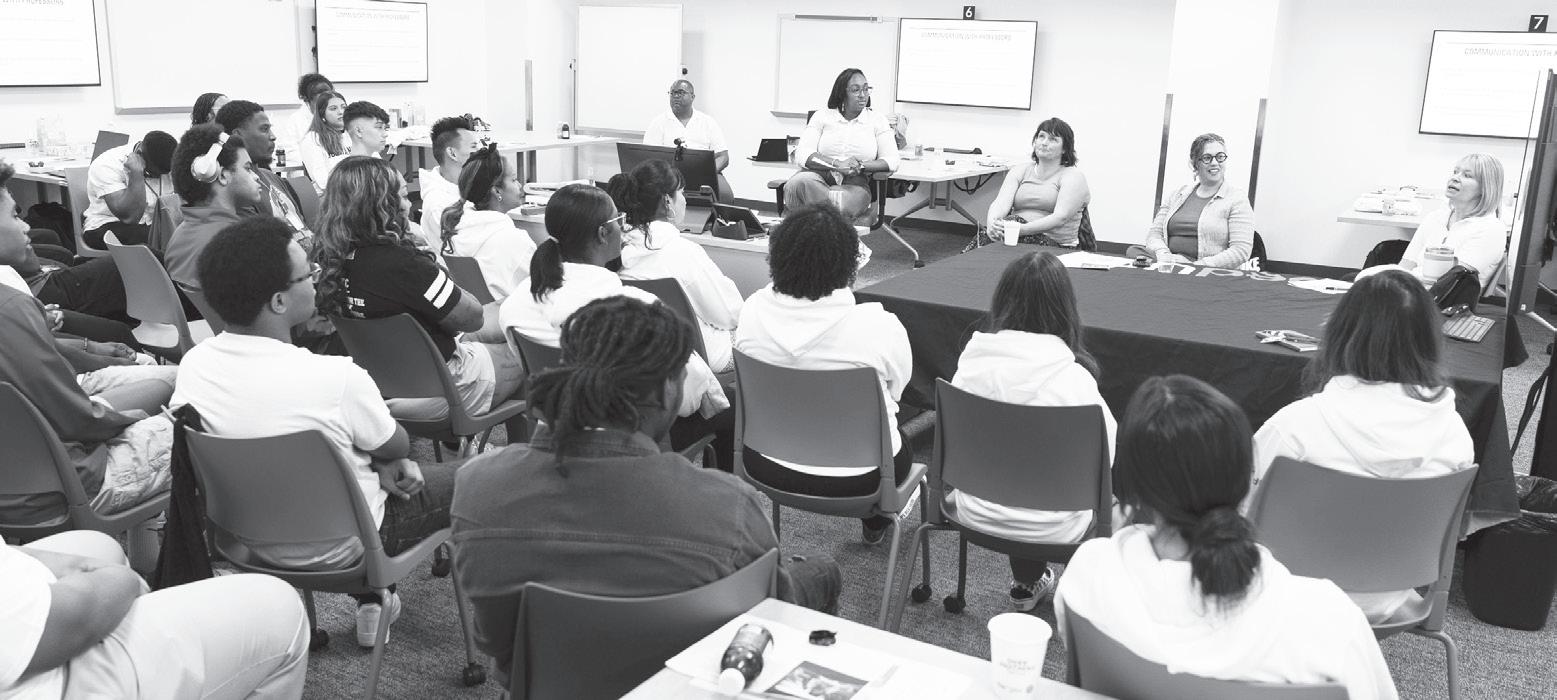
The program also features a cohort model that provides a supportive learning community, fostering collaboration and a sense of belonging among participants. In addition, it emphasizes professional development with activities specifically aimed at enhancing teaching skills and preparing students for their future roles. Proactive advising ensures a smooth transition to a bachelor’s degree program in special education, guiding students through their academic and career paths. Finally, the program connects students to essential campus resources, ensuring they can access the support services needed throughout their educational journey. These comprehensive offer-
ings collectively aim to facilitate academic success and career readiness for students in the SpedUP Program.
On August 13, 2024, Normandale Community College hosted a panel to provide SpedUP students with valuable insights on effective time management. Leticia Alvarez led the discussion alongside Dr. Sarah Toland, Dr. Jen Westmoreland, and Professor Cindy Carow-Schiebe. They emphasized professional development and personal well-being in becoming special education teachers.
Leticia Alvarez, a distinguished graduate of the SpedUP program and a seasoned paraprofessional with Bloomington Public Schools, kicked off the dialogue by expressing
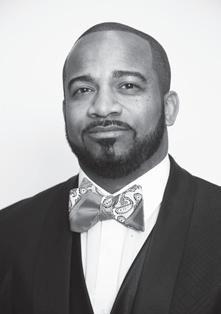

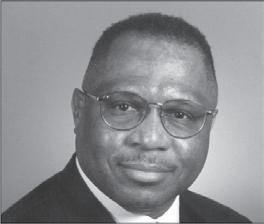
her commitment to ensuring future educators receive the support they need. “My dream is that I’m walking so you can run . . . Know that I am trying my best on the ground to make sure that when you all are in that transition period, you have these supports in place, and if they’re not, call me,” she said, highlighting her dedication to improving support systems for students transitioning to four-year programs.
The conversation then delved into effective communication with professors. Carow-Schiebe shared strategies for students to engage with their professors. “Think about how you want your students to approach you, and then do that. If you want to teach your students to talk to

negative stereotypes and lead to ongoing disparities in care.
The study’s authors emphasize that understanding and addressing these biases is crucial for improving health outcomes for minority populations.
King and her team hope their research will be a wake-up call to the medical community. “If we can develop and refine algorithms to detect such biases, we can raise awareness among clinicians during patient interactions,” King said in the release.
“This heightened awareness could be a critical step toward more equitable healthcare.”
The study also points to the need for systemic changes in how medical professionals are trained and how EHRs are utilized. While EHRs are essential for documenting patient care, officials noted that the language used in these records can reflect unconscious biases that may influence patient outcomes. They said
you, you have to practice that so you can guide them,” Cindy advised. She also emphasized the importance of connecting with professors in person or via email to enhance learning experiences and support.
Westmoreland reiterated that point, proclaiming, “Professionally, those are the moments that I live for! I love connecting with students before or after class, in the hallway, on Zoom, whatever.”
The SpedUP participants sat silently and diligently took notes as the panelists spoke. Their respect for those in front of them was apparent. They had already resolved to model the behaviors and attitudes they expect from their future students themselves.
the research underscores the importance of ongoing education and training for healthcare providers to recognize and mitigate these biases.
The study’s findings open the door for further research into the relationship between biased language in medical records and patient outcomes. The research team, which includes experts from institutions such as the University of North Carolina at Charlotte, the University of Houston, and Duke University, plans to explore whether biased language correlates with poorer health outcomes for minority patients and whether interventions can reduce these disparities.
Stacy Brown is the national editor for NNPA News Services. The study, supported in part by a grant from the Rice Race and Anti-Racism Research Fund, was published in JMIR Medical Informatics and is available online.
tune the panelists were with the students.
Alvarez’s advice to add selfcare tools to one’s routine resonated strongly, emphasizing, “You cannot pour from an empty cup. You must ensure you’re whole and well, especially when serving your students.”
The discussion continued with practical advice on finding effective self-care routines. Toland shared her experiences trying various strategies until she found what worked best for her. “People will give you advice that may not work for you,” she noted. “Recognize that and let it go. Lean into what works for you.”
Alvarez encouraged students to communicate openly and seek peer inspiration, saying, “Talk to each other. The thing that’s so amazing about this cohort model is that you have the support of one another. Pull inspiration from each other.”
Another key topic was the critical aspect of self-care, with panelists sharing strategies for maintaining well-being amid demanding schedules. One student mentioned that exercise and yoga, particularly hot yoga, were essential for their peace and restoration. Alvarez responded with a mix of humor and upliftment, suggesting, “Okay, put me on! Let’s go sweat. I don’t want to sweat this press out, though!”
The hearty laughter around the room reflected how in
As the event concluded, the panel underscored the SpedUP program’s role in addressing the shortage of special education professionals and promoting diversity within the field. Normandale Community College’s commitment to supporting BIPOC students through the SpedUP program reflects a broader effort to enhance educational equity and ensure a well-prepared and diverse workforce for the future.
Alexia Shobe welcomes reader comments at ashobe@ spokesman-recorder.com.
















Afro-American, where he spent nearly 60 years, from his hospital bed just days before his death at age 99 in 2003 from heart and kidney failure.
Smith also is in the Baseball Hall of Fame, but posthumously in 1993. He began his journalism career in 1937 with the Pittsburgh Courier and later worked in television in Chicago in the mid-1960s, writing a weekly column for the Chicago Sun-Times up until his death from pancreatic cancer at age 58 in 1972, a month after Jackie Robinson’s death.
During his first year in the majors, Smith was by Robinson’s side “and ghost writing his column and being his roommate, his driver and everything,” said Dawkins.
“They did more than just baseball,” said Dawkins to the
Continued from page 14
approval to sell their streaming rights this year.
“We have been unable to screen Twins baseball in this market,” reiterated St. Peter.
“I can assure you that as we look to 2025, we will be looking to do that with partners that can help [us]. The good news is we have options.”
But do baseball fans have the same options?
Cable and streaming can be costly. The RSN situation is in flux—the Twins contract with Diamond Sports expires at season’s end.
Radio still remains a viable option for baseball fans,

MSR after his appearance on NABJ Book Spotlight. Both Lacy and Smith covered other sports. Lacy fought against segregation in pro football, and Smith covered both Joe Louis and Sugar Ray Robinson during their championship runs.
“There’s a chapter that focuses on boxing,” said the author. “Smith often was at his best covering boxing,” and Lacy often criticized Robinson as a great fighter “but a despicable human being,” added Dawkins.
“They deserve their own story, their own biographies of who they are,” said Dawkins.
When he was approached to write about Lacy for a history journal, Dawkins said he would do it but not without Smith. “They were two Black sports writers of that era,” he recalled. “They were the two people who vetted Jackie Robinson to be the best person to desegregate Major
even if it’s only in their cars.
WCCO Radio has been the Twins broadcast home since 2018, but the contract ends at the end of this season.
“Radio is still an important part of our business,” said St. Peter. “It’s an important part of the way we showcase our brand. It’s still destination programming for a lot of fans throughout the Upper Midwest.
“I can tell you that we will not proceed with a radio partnership that doesn’t have some level of destination as to where you can find the game,” pledged St. Peter.
The MSR afterwards asked St. Peter about the future of baseball broadcast locally and nationwide. What about those fans without cable, sat-
League Baseball.”
Not enough is said or written on just how influential and impactful Lacy and Smith both were as journalists, Dawkins pointed out.
“We can’t say enough about the Black Press and its role in integrating so many institutions in this country. That is what this book is all about,” he added. “The fact that there were these two men [who worked] for the Black Press and made their views known on all sorts of issues.”
Smith also supported Black female athletes and worked hard to dispel the notion that their success wasn’t abnormal. Such as tennis pioneer Athena Gibson: “Smith went out of his way to say yes, she’s a great athlete in tennis, but she’s a girly girl,” surmised Dawkins on Smith’s writings about Gibson.
Charles Hallman welcomes reader comments to challman@ spokesman-recorder.com.
ellite, or computer access for whatever reason, including affordability. Would they be left out in the cold?
“The media landscape is evolving,” he responded. “I suspect that over time it’s going to continue to change. We recognize the importance of the reach of our broadcast.
“We know cable and satellite will still be here for some. We believe streaming [is] critical for others,” said St. Peter. “But I also believe that there is a place for over-the-air traditional broadcast. So it’s probably a combination of all of the above.”
Charles Hallman welcomes reader comments to challman@ spokesman-recorder.com.





















































































oward University in Washington DC is a historic private HBCU institution founded in 1867. It has an excellent law school, and will spend at least $785 million dollars over the next four years to build a new STEM complex and new academic buildings for its fine arts and communications schools, as well as renovate other oncampus buildings.
Vice President Kamara Harris last week welcomed new students to Howard—the Democratic presidential candidate is a Howard alum.
Besides football, Howard sponsored 21 NCAA Division I men and women’s varsity sports representing three

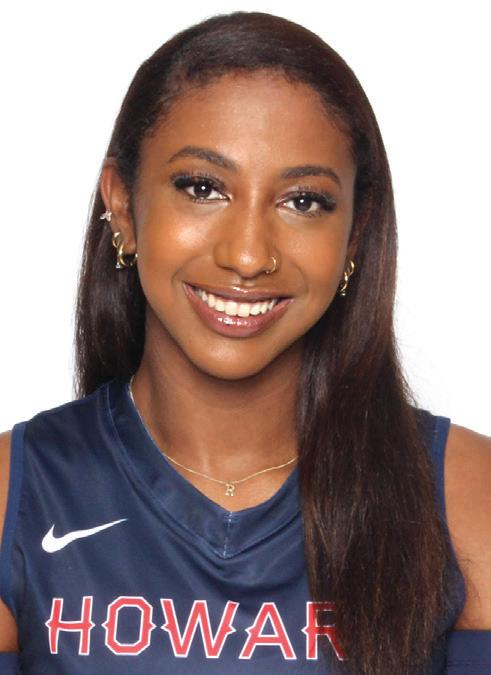
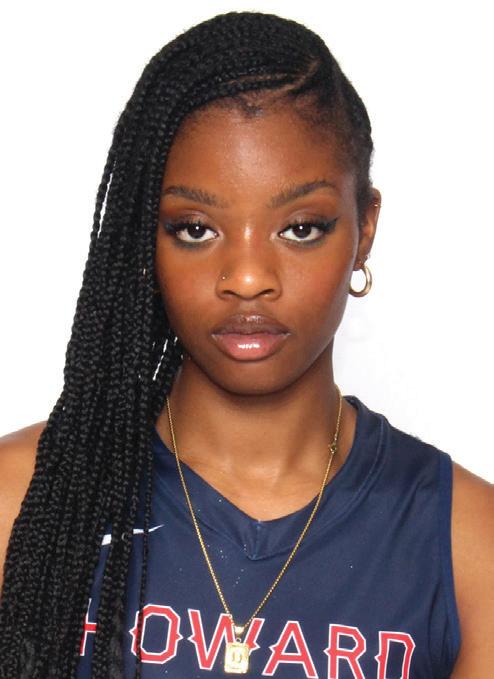
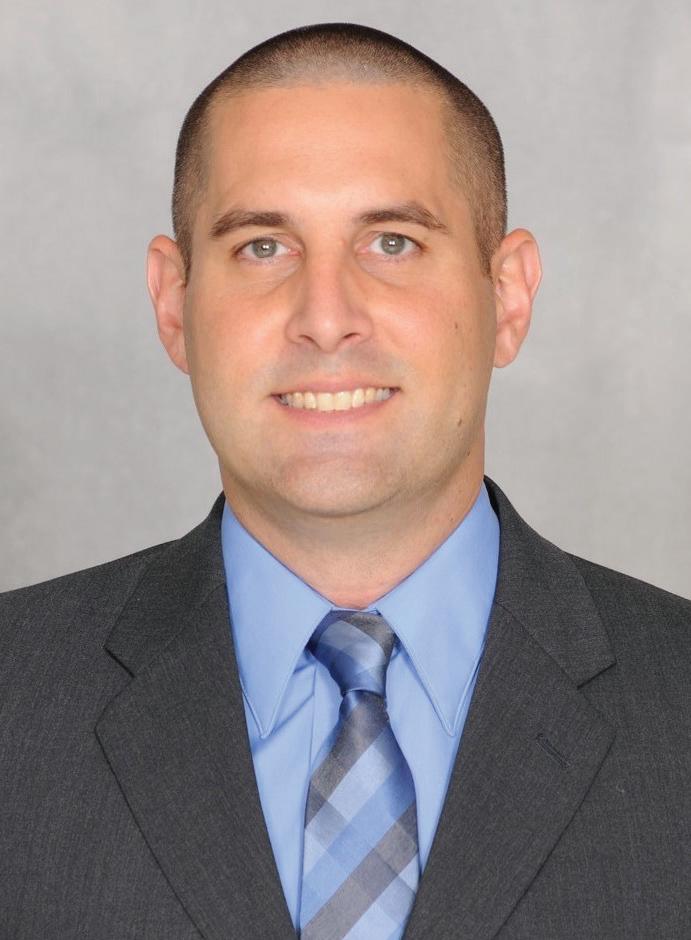
stead NY), “We’re excited to see her play some live games here,” said the coach.
The Big Ten, now at 18 teams, is considered one of if not the best volleyball conference in the nation. Kupferberg pointed out, however, that the eight-team MEAC is no slouch either.
“We’re competing at all levels,” he reiterated. “We can compete at that high level, and we have the athletes to definitely do that.
“The biggest thing people don’t understand is what the skill level is here…the size and speed and strength of our athletes.”
conferences: the Mid-Eastern Athletic Conference (MEAC), Northeast Conference (NEC), and Eastern College Athletic Conference (ECAC).
The MSR recently talked to
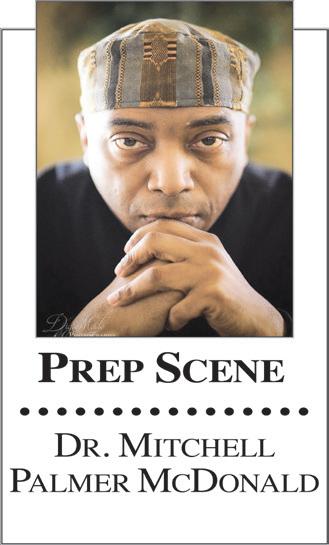
he Minnesota Lynx (188) got right down to business after the Olympic break, defeating the Washington Mystics (6-20) 79-68 at Target Center last week.
Olympic gold medalist power forward Napheesa Collier led the way with 17 points and 12 rebounds. Point guard
Courtney Williams added 14 points while forward Alanna Smith and shooting guard Kayla McBride each had 12. Shooting guard Ariel Atkins led the Mystics with 12 points. Point guard Brittney Sykes finished with 11 and guard
Volleyball Coach Shaun Kupferberg, who in 10 seasons turned the Bison from an alsoran to among the MEAC elite. From winning only one game in 2012 to five consecutive conference crowns (2015-19), the three-time MEAC Coach of the Year has led Howard to five 20-win seasons and at least a share of the MEAC Northern Division title in five
of the last seven years, as well as six NCAA trips, five straight.
“All the Howard sports [teams] are doing really well right now,” declared Kupferberg. As far as his spikers, “I think we’ve been pulling our weight and doing a good job,” added the coach. “We’re competing at a national level.”
Kupferberg admitted that there is a common misconception about Black college volleyball. “The biggest thing is people don’t understand what the skill level is here. You have people that don’t understand the size and speed and strength of our athletes,” he stressed. “We’ve got plenty of
girls that can dunk a basketball fairly easily. And so they’re big, physical, hit the ball well, and we’re a very strong athletic team.”
The 2024 Bison volleyball team returns 12 players from last season’s 17-15, 11-3 MEAC squad. This includes Rya McKinnon, a 5’11” junior outside hitter from Hoover, Ala.
“She’s been the conference player of the year her last two years. She’s sort of an allaround player that does everything for us,” noted Kupferberg on McKinnon, a stellar student and an elite performer once recruited by ACC schools. But she chose Howard.
Senior middle blocker Cimone Woodard, 6’3”, from Missouri City, TX, “is a superstar middle no matter what match we’re playing in. She’s usually the best middle on the court, and she’s able to terminate the ball very well,” noted her coach.
Claire Simpson (5’6” junior libero, Plainfield, IL) “has taken a big step forward… She’s super fast and she’s really starting to lead the defensive portion of our game,” continued Kupferberg.
Of senior outside hitter Dami Awojobi (6’1”, Hemp-
“I think that every team in our conference has gotten better since I’ve been a part of this conference,” said Kupferberg.
Howard’s 2024 women’s volleyball season begins at home against George Mason on August 30.
“I think we’re hitting another stretch where we’re going to see a quick improvement in our team,” concluded Kupferberg. “We’re going to see where we’re at right off the bat. And I think we’re gonna go compete and compete really well.”
Charles Hallman welcomes reader comments to challman@ spokesman-recorder.com.

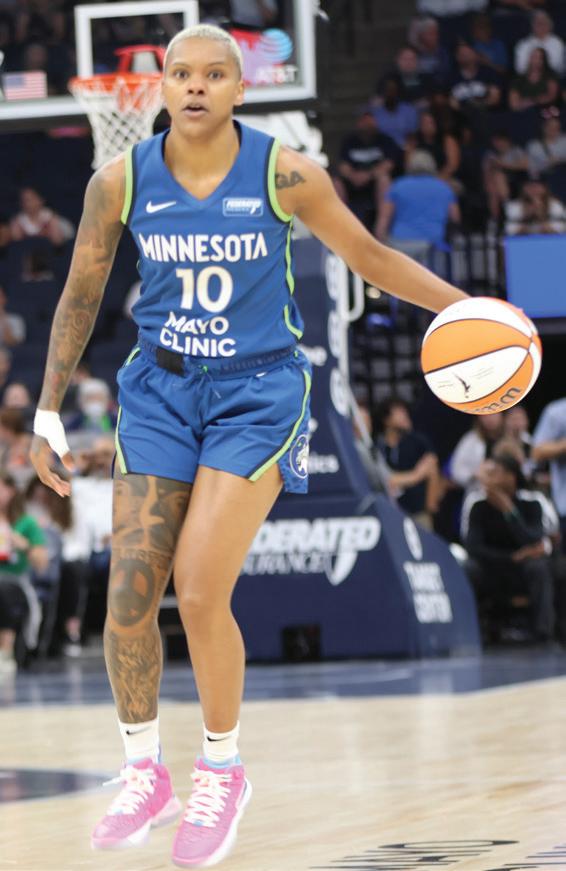
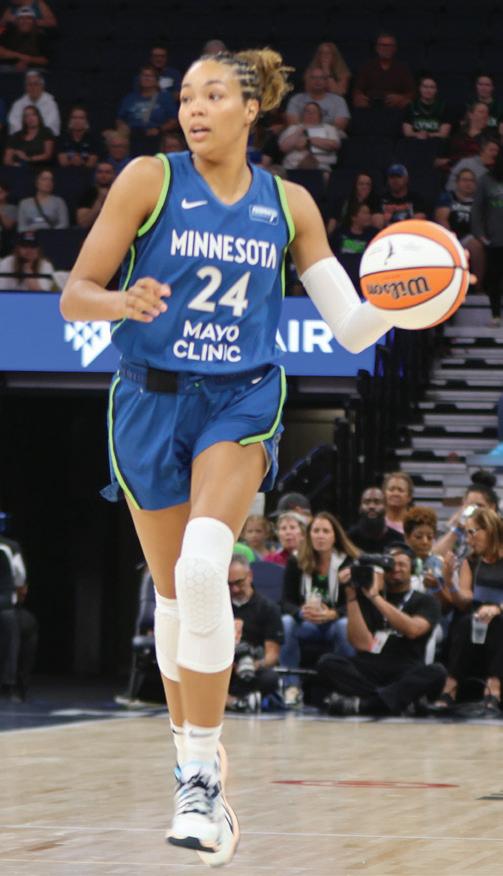
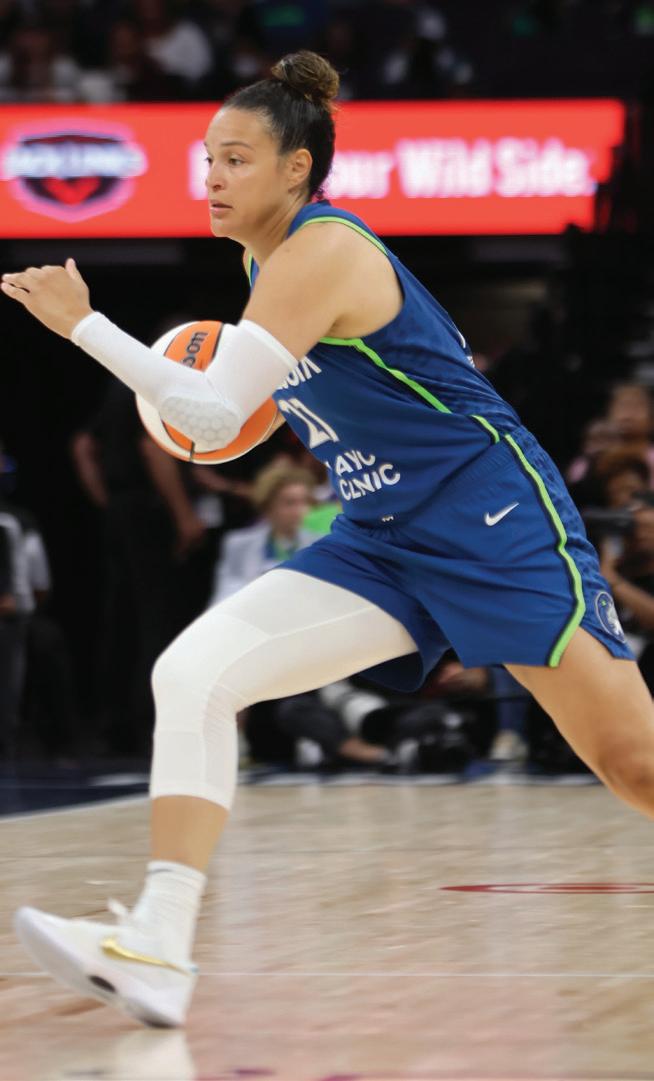

Jade Melbourne chipped in 10. McBride’s two steals and clutch free-throws in closing minutes sealed the victory.
Dr. Mitchell Palmer McDon
ald welcomes reader comments

Second of two parts
am Lacy and Wendell Smith were two legendary Black sportswriters whose constant writings eventually led to American sports becoming desegregated.
Wayne Dawkins discusses this in his latest book, “Sam Lacy and Wendell Smith—The Dynamic Duo That Desegregated American Sports” (Routledge) that was released in June.
Dawkins, a veteran Black journalist and college professor, was approached back in 2013 about writing a historical book when Smith was inducted into the NABJ Hall of
Fame, he told Black journalists in Chicago during the NABJ annual convention.
Lacy (1903-2003) and Smith (1914-1972) both advocated for integration in sports as early as the 1930s in the Black Press. Both men covered the Negro Leagues in its heyday before MLB’s racial barrier was broken when Jackie Robinson joined the Brooklyn Dodgers in 1947.
Lacy in 1997 was inducted into the Baseball Hall of Fame
“We can’t say enough about the Black Press and its role in integrating so many institutions in this country.”
for his baseball writing—he was one of the first Black members of the Baseball Writers Association of America (BBWAA). He wrote and filed his final column for the Baltimore
■ See VIEW on page 13
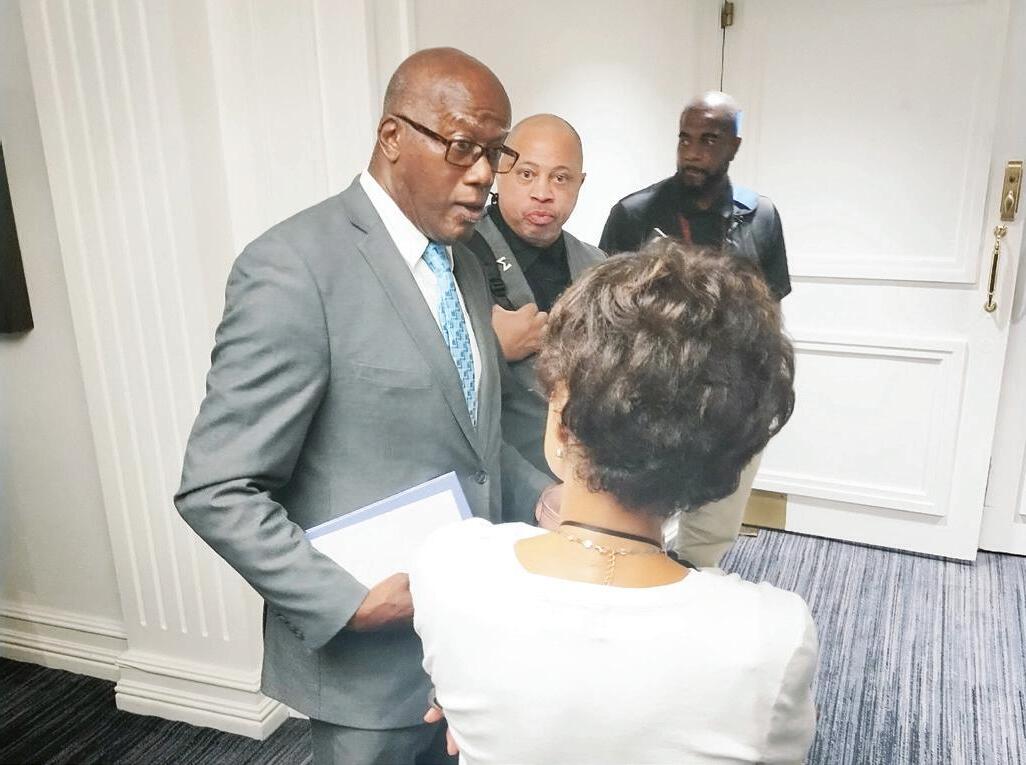
Evolving media landscape complicates baseball broadcasting
By Charles Hallman Sports Columnist
he Minnesota Twins are back on television.
A contract dispute over pricing tiers between Comcast and Diamond Sports Group, which owns Bally Sports North, put the Twins, along with the Minnesota Lynx, off the air for three months, starting on May 1. The two sides finally reached an agreement,
“Radio is still an important part of our business.”
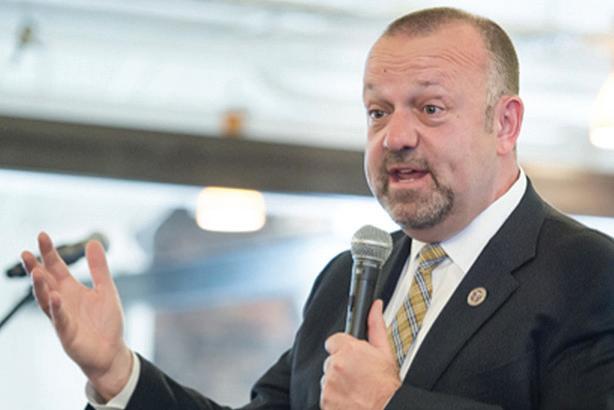
“Anybody that thinks they know where this is going to play out over the next six weeks, six months, six years, six days, they are B.S.-ing you because we don’t know,” admitted the longtime Twins executive. The future of baseball broadcasting on all media platforms are evolving.
Once upon a time, baseball fans could watch their favorite team on over-the-air television. Then came the advent of regional sports networks
(RSNs), and slowly but surely, teams such as the Twins moved their game broadcasts from regular TV to cable and satellite TV. Now, cable “cord-cutting” by subscribers has reduced the revenue that RSNs received from television provider subscriber fees and advertising. And in recent years, streaming has become vogue for many sports fans, though not this year for Twins